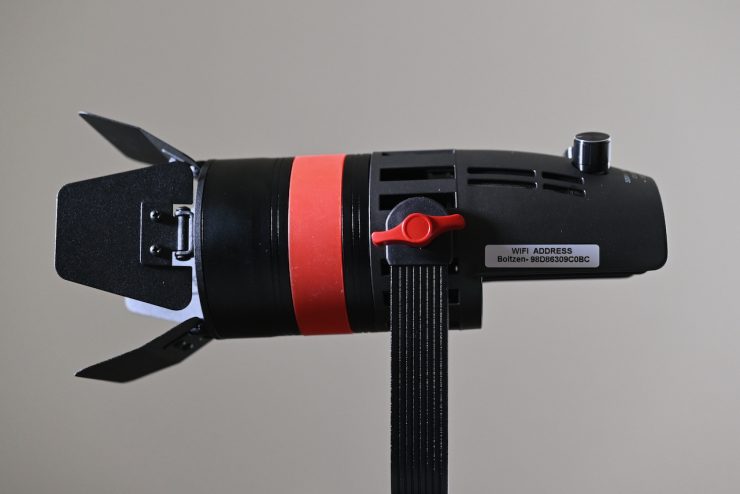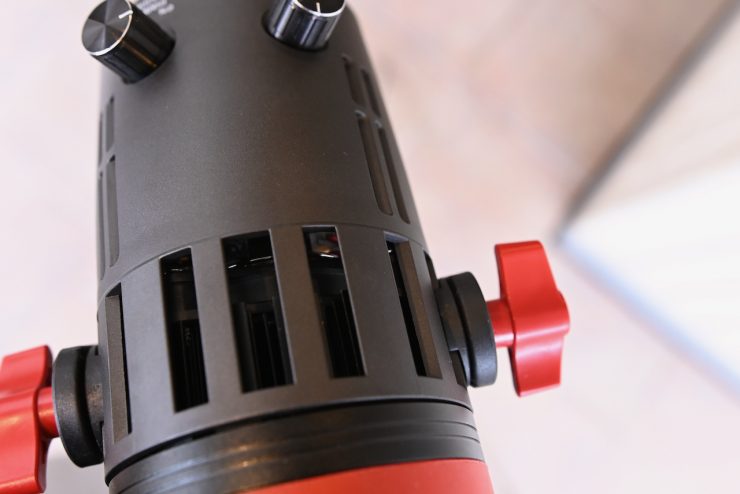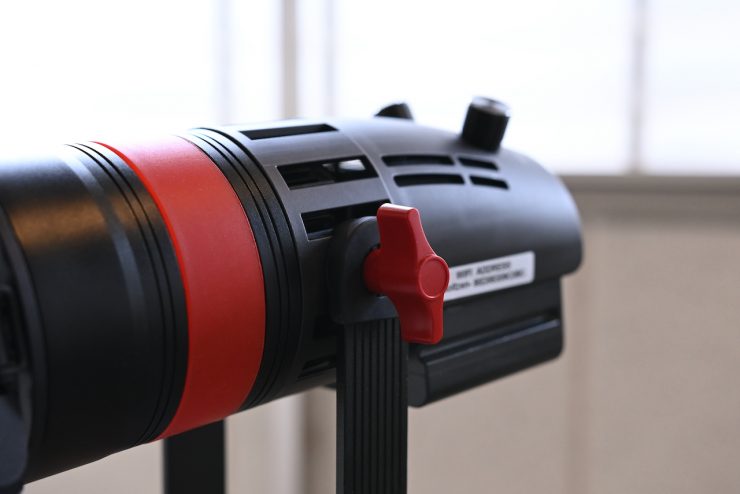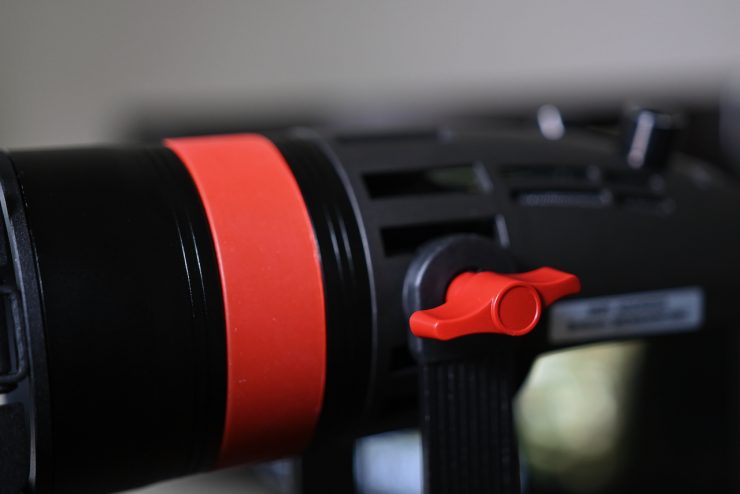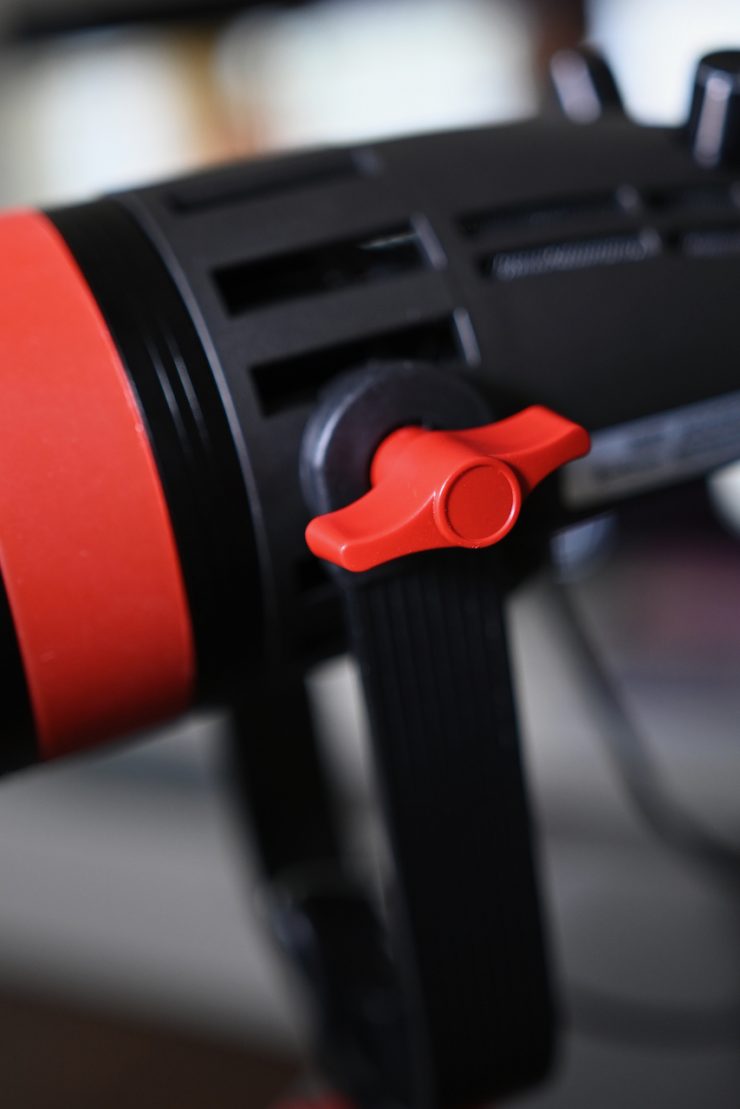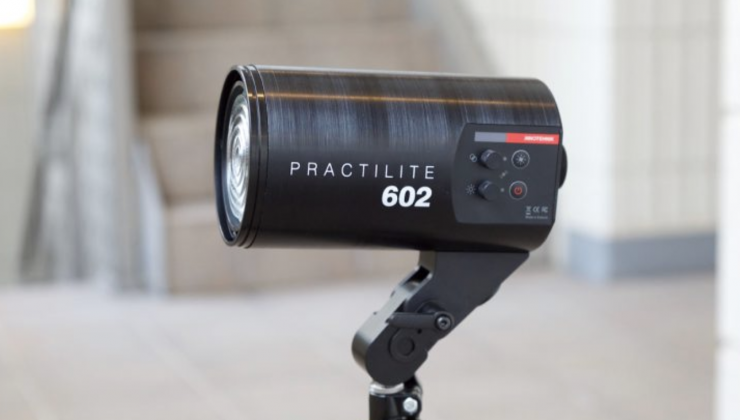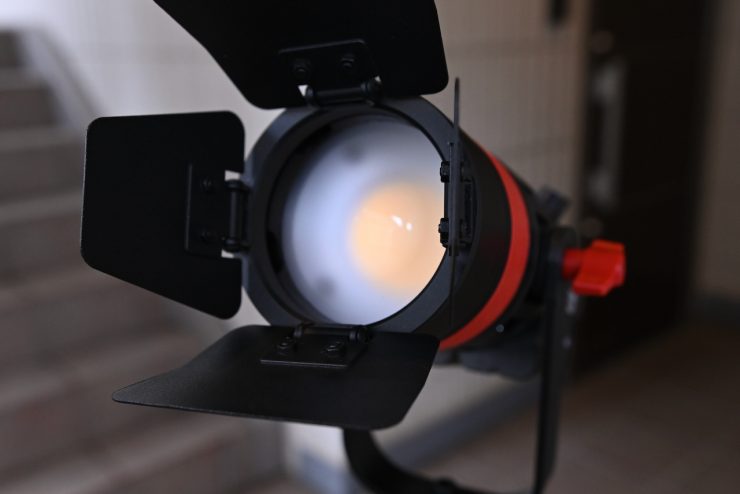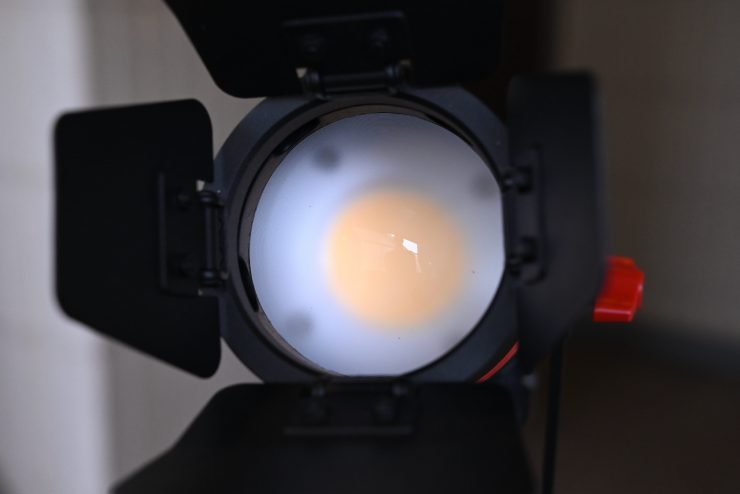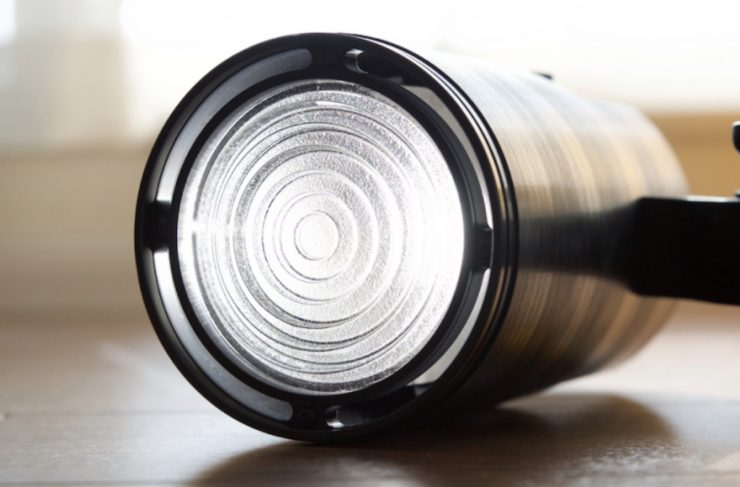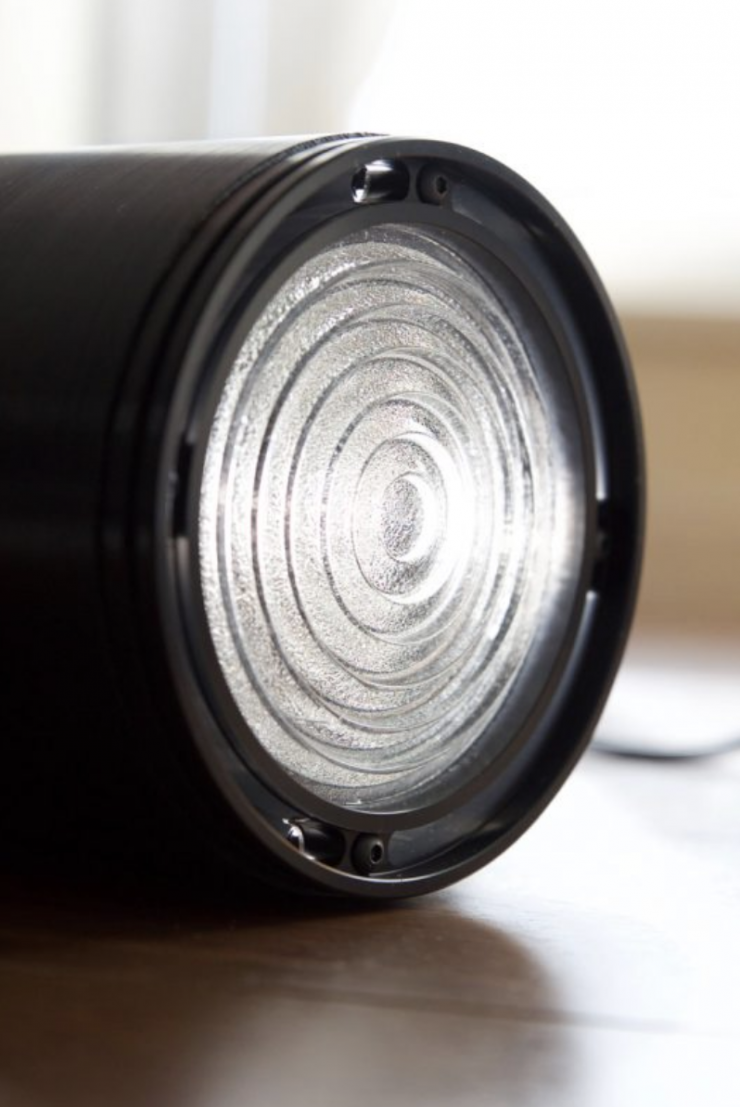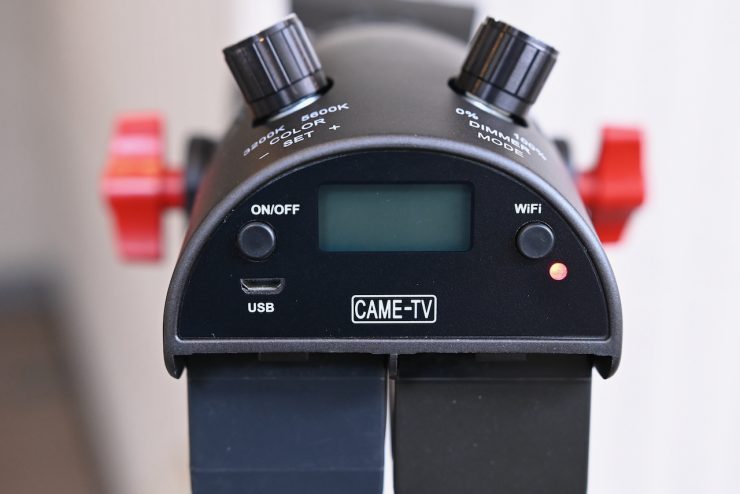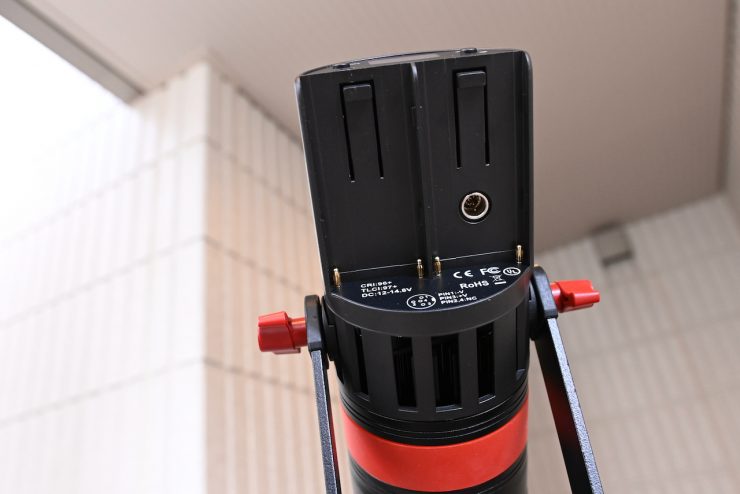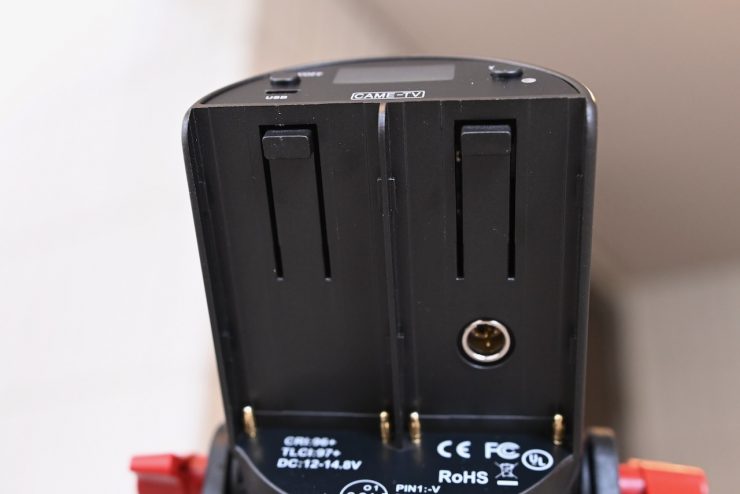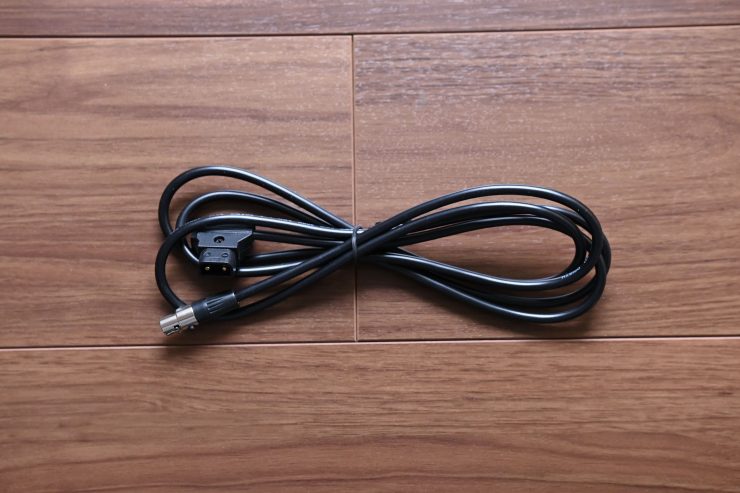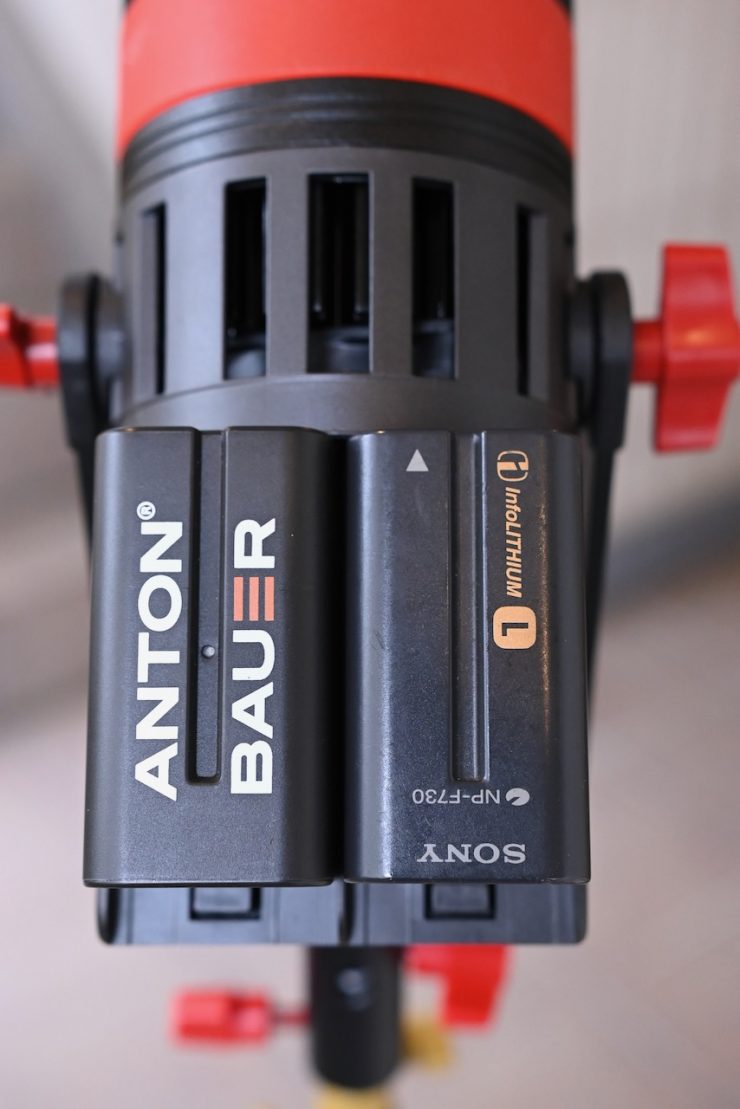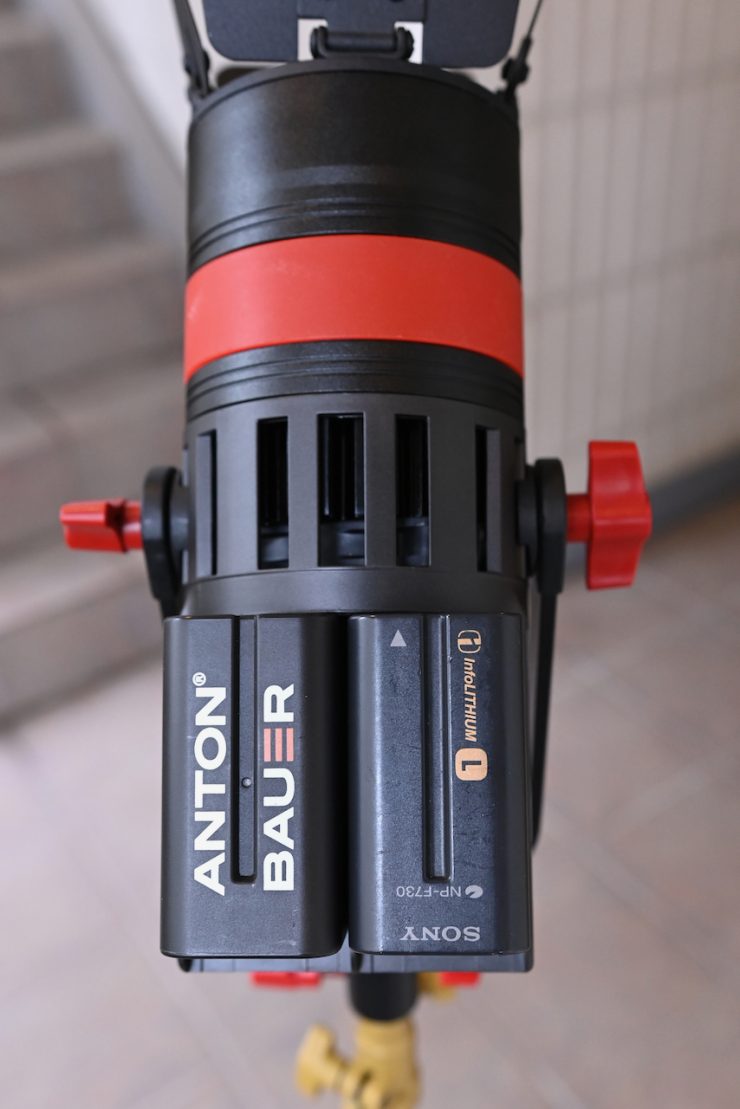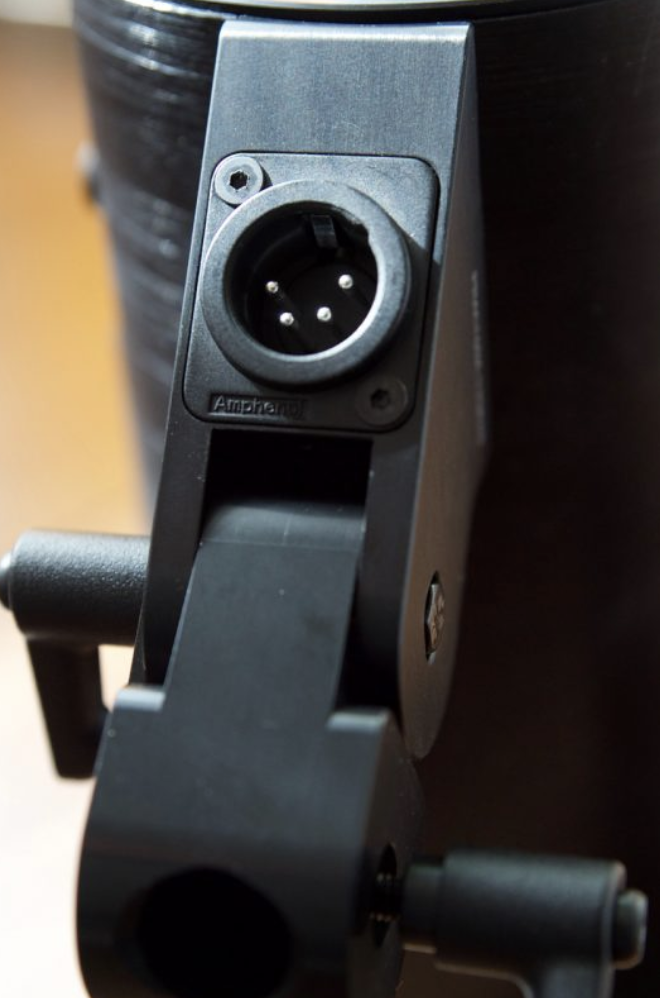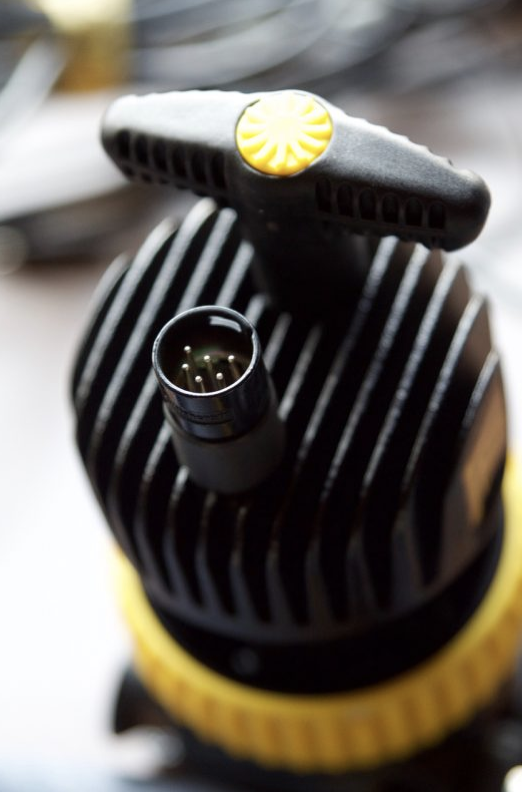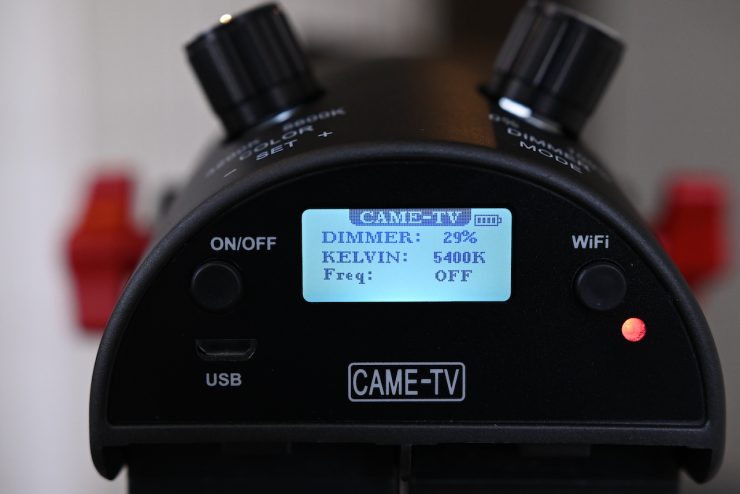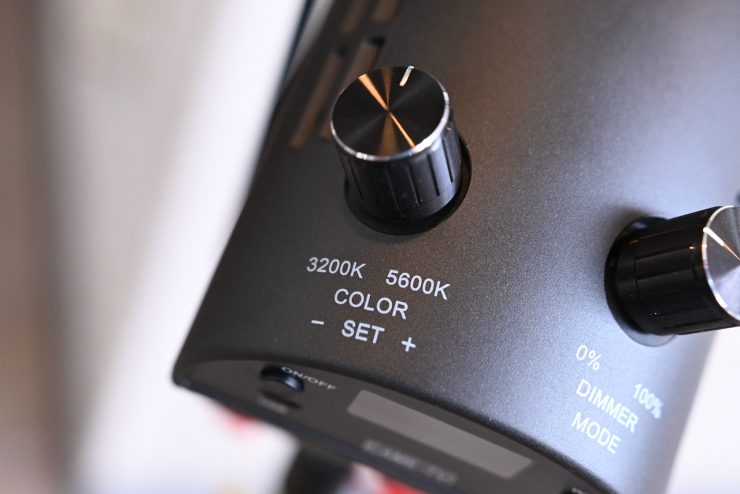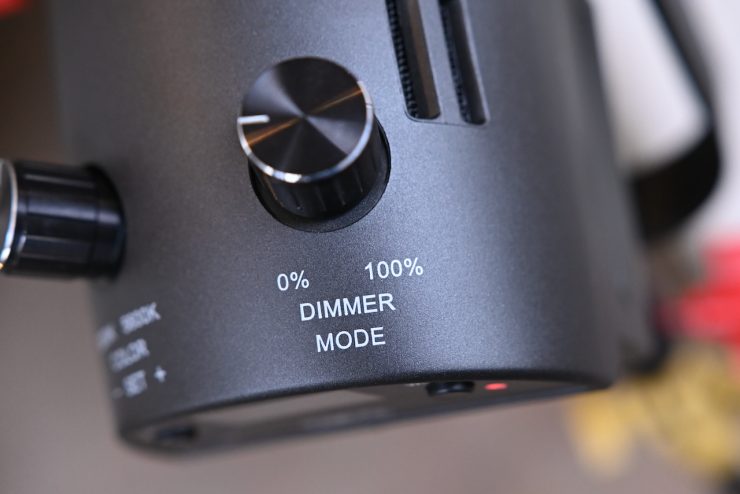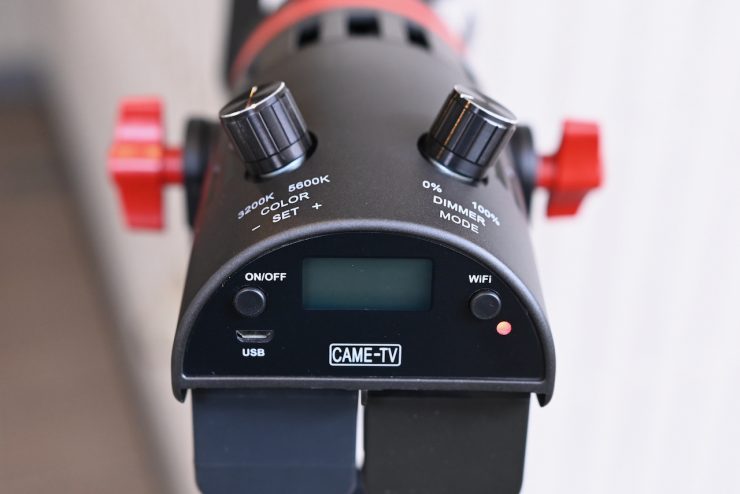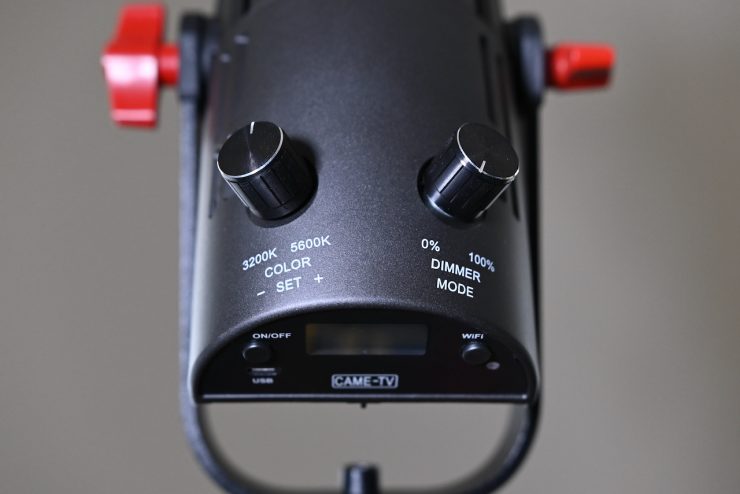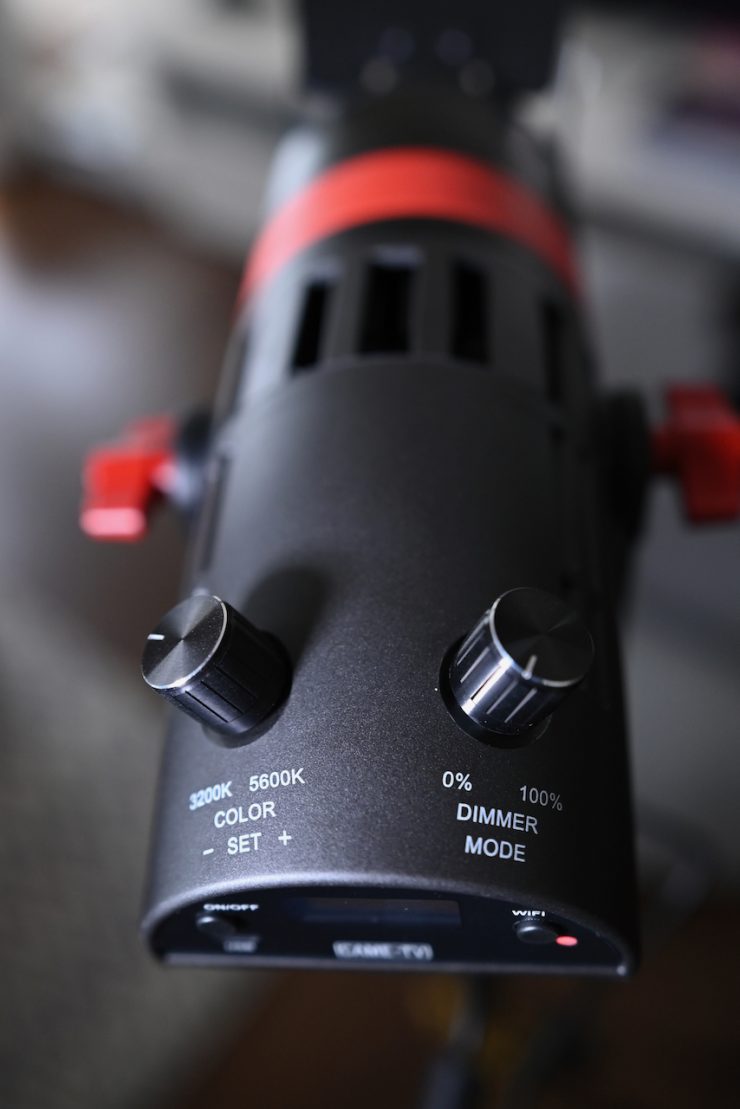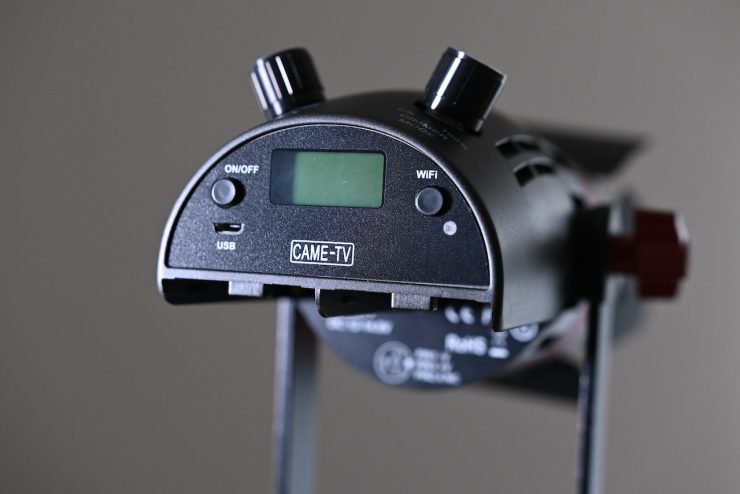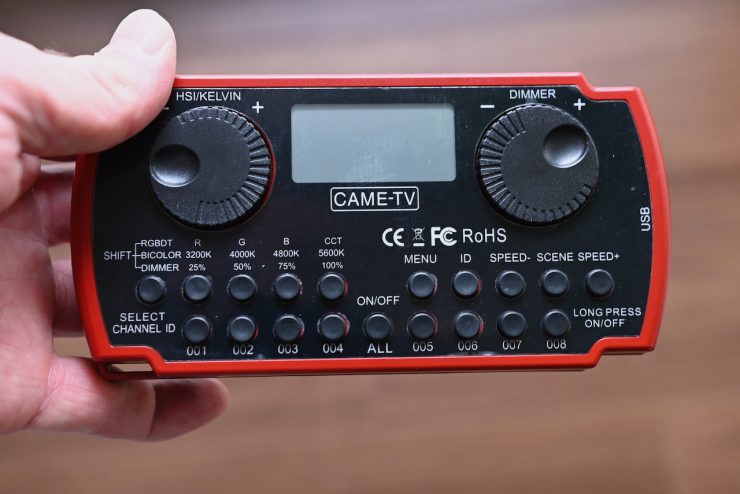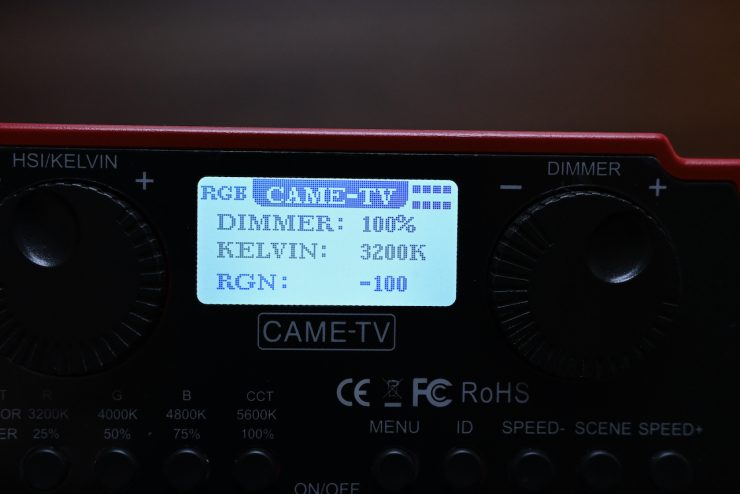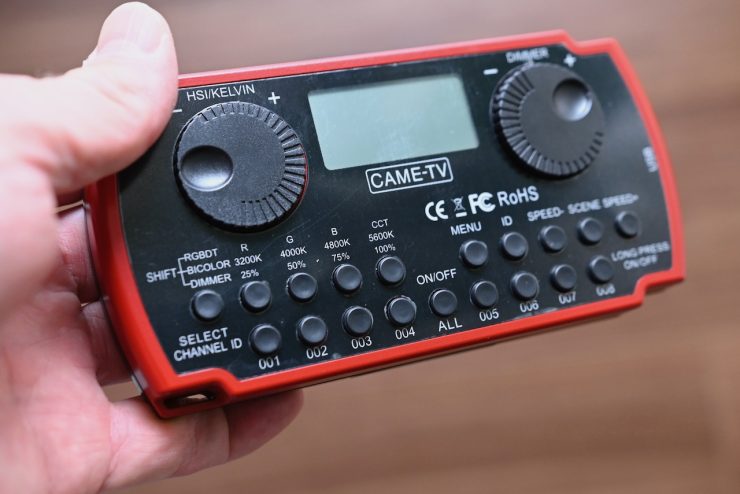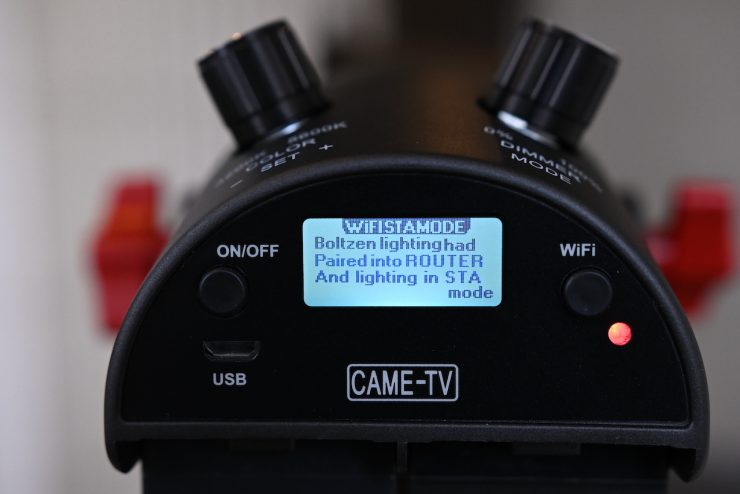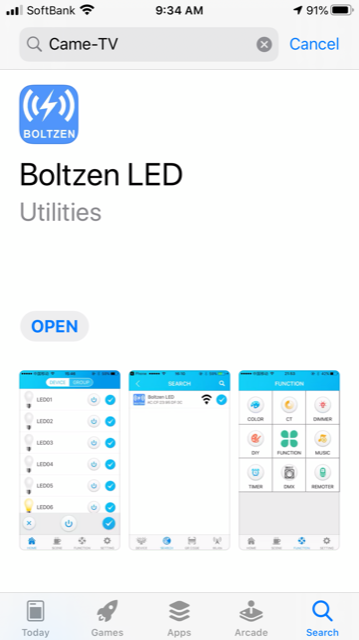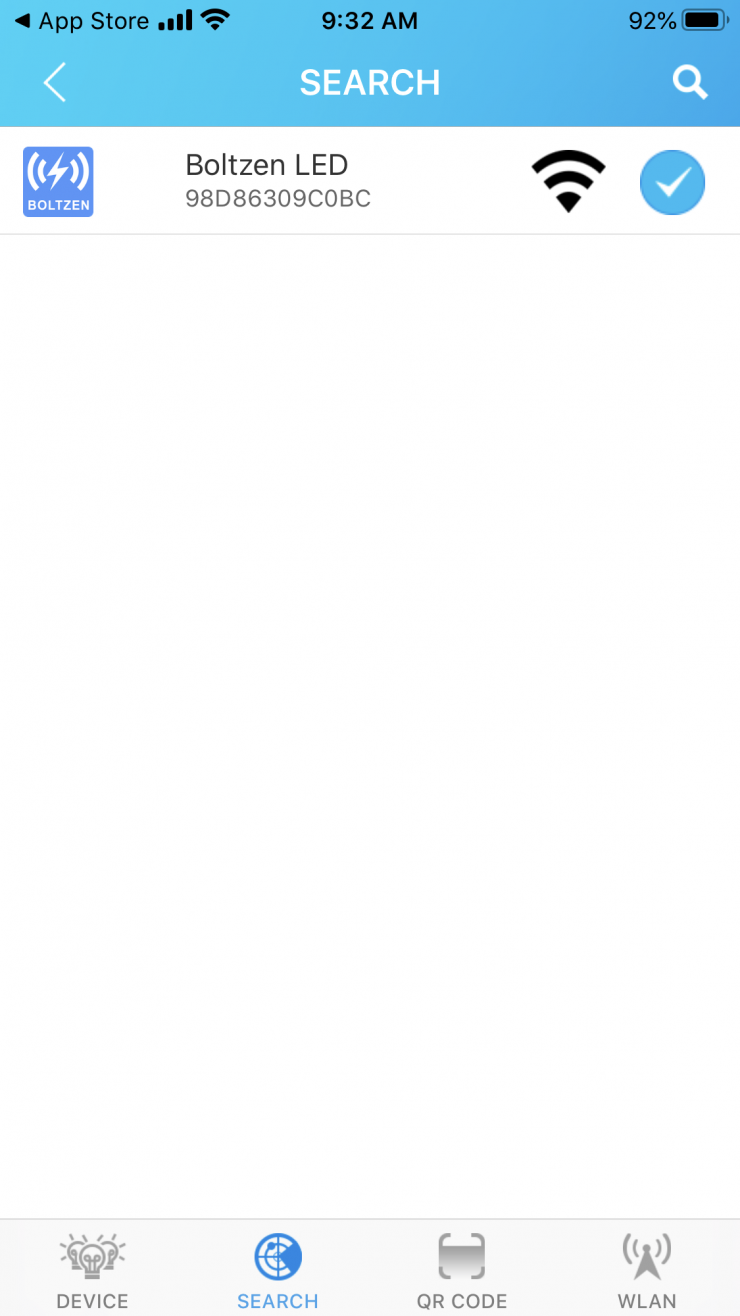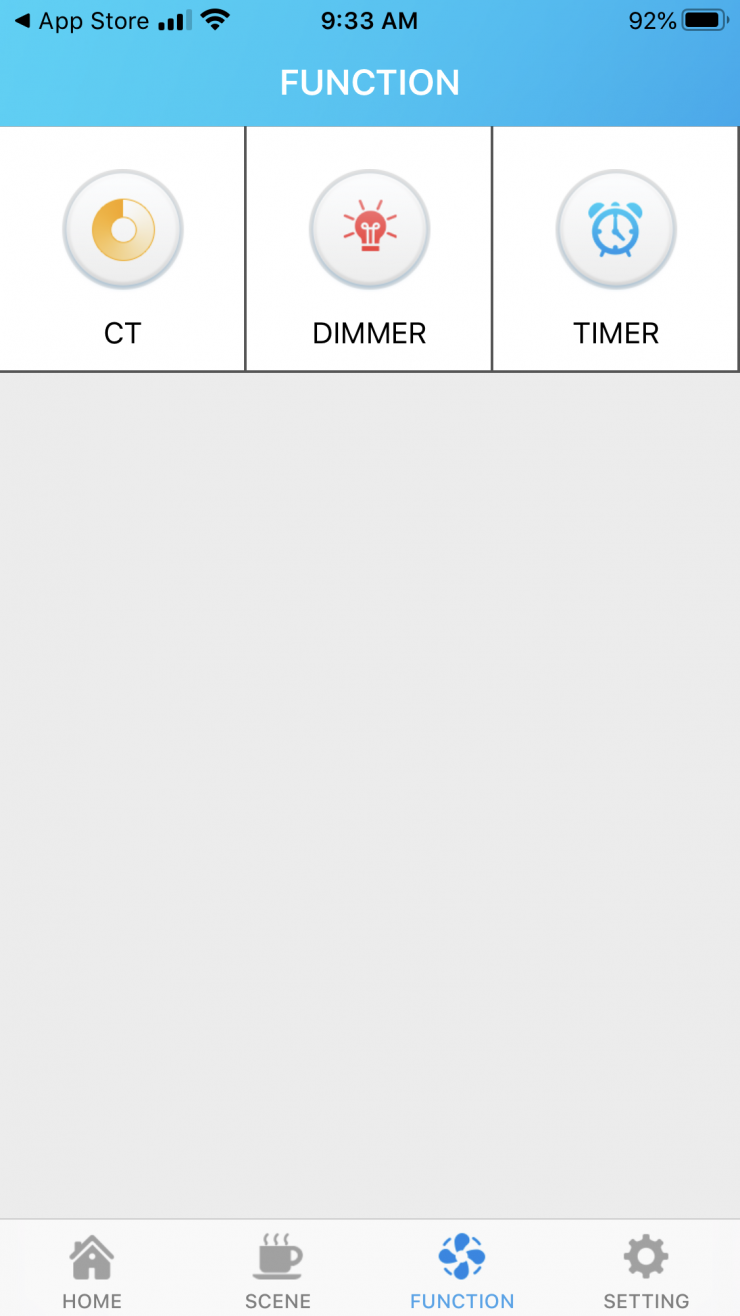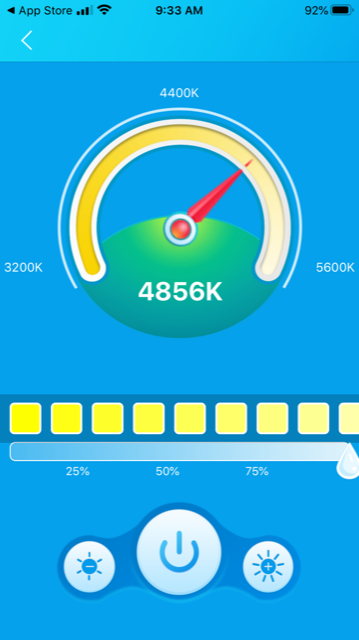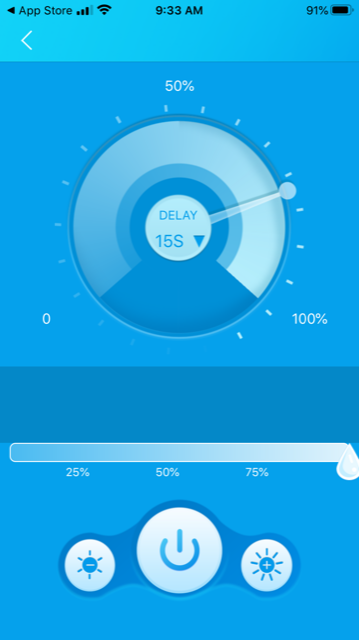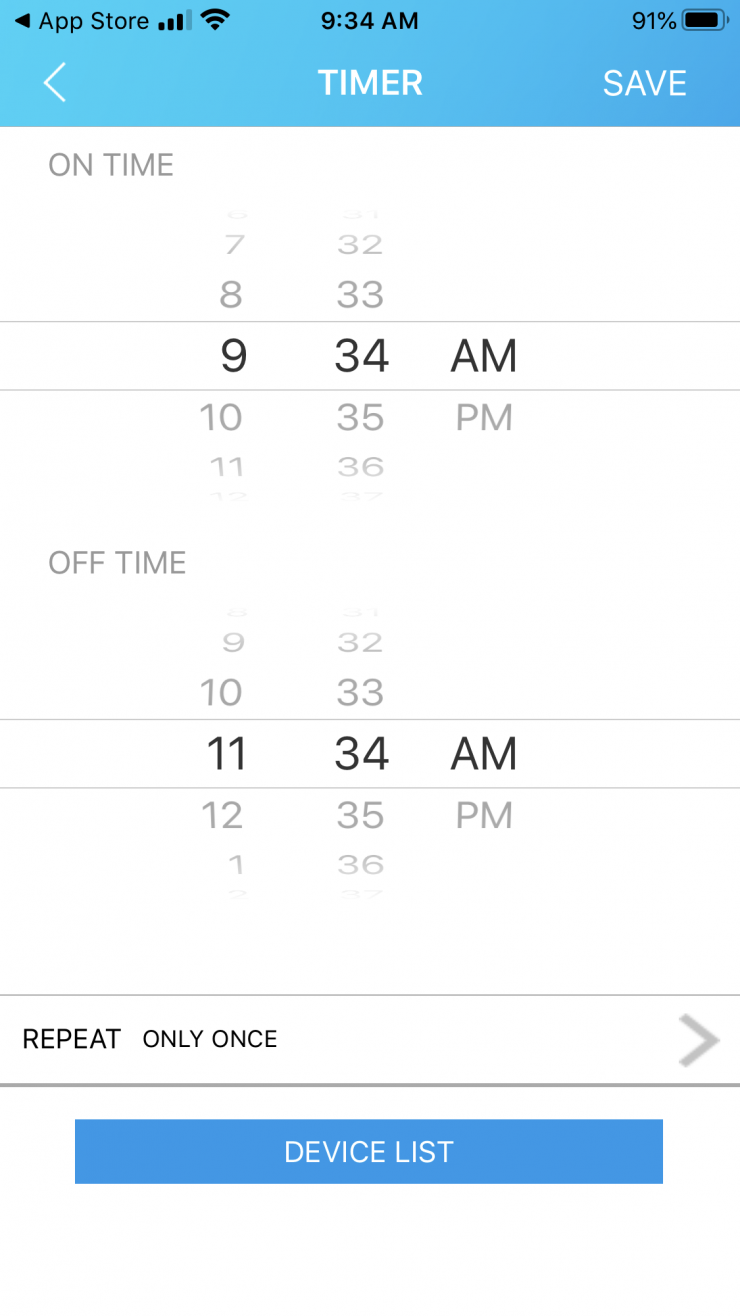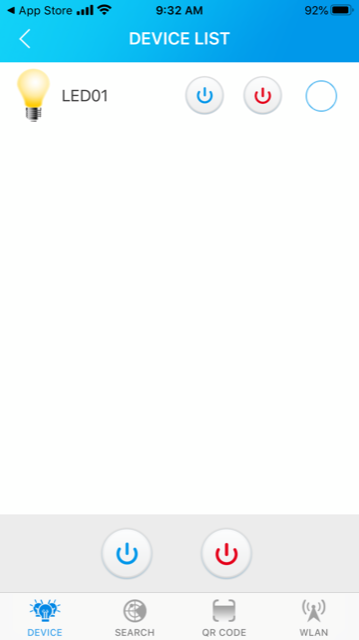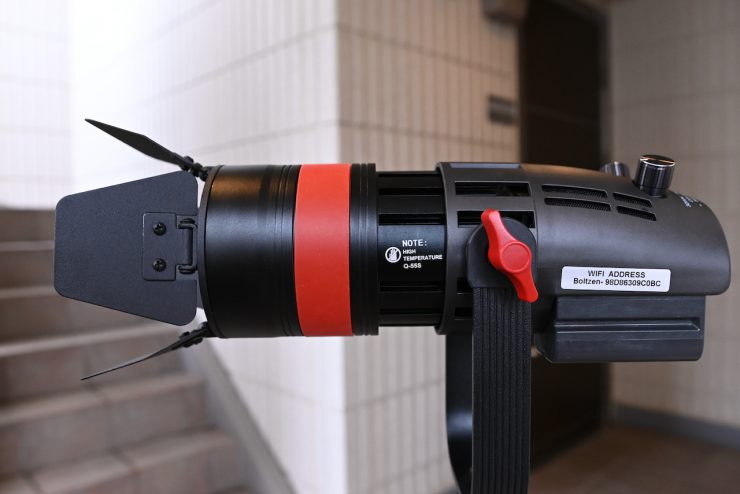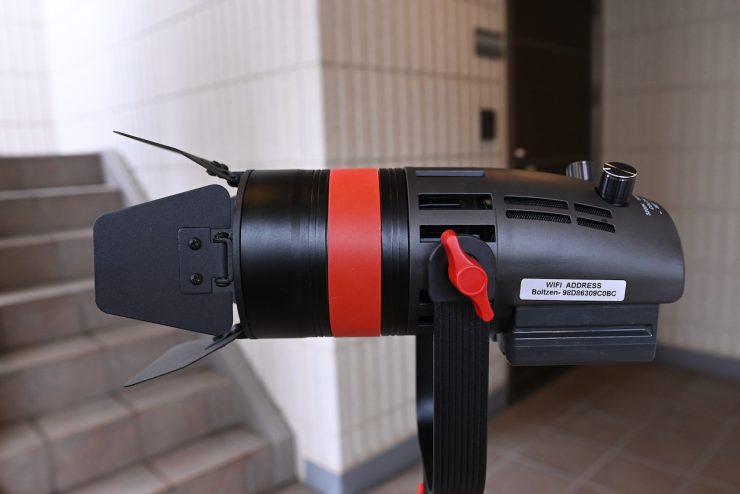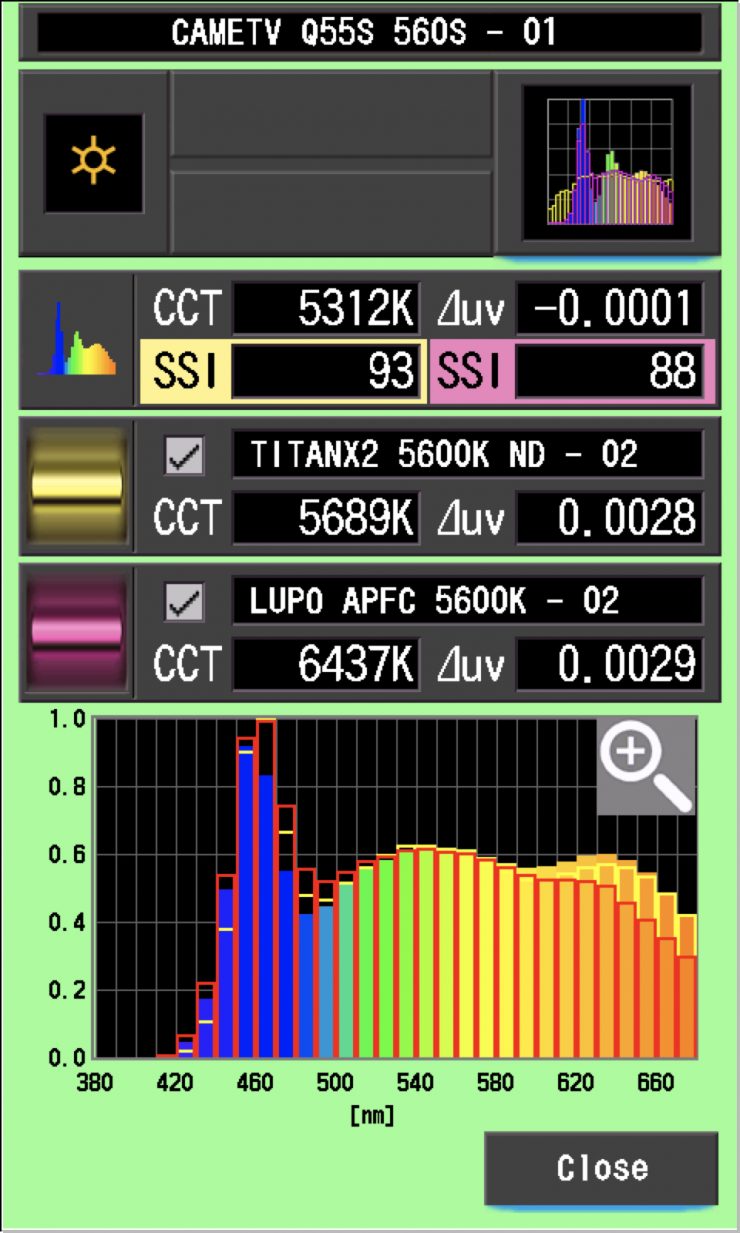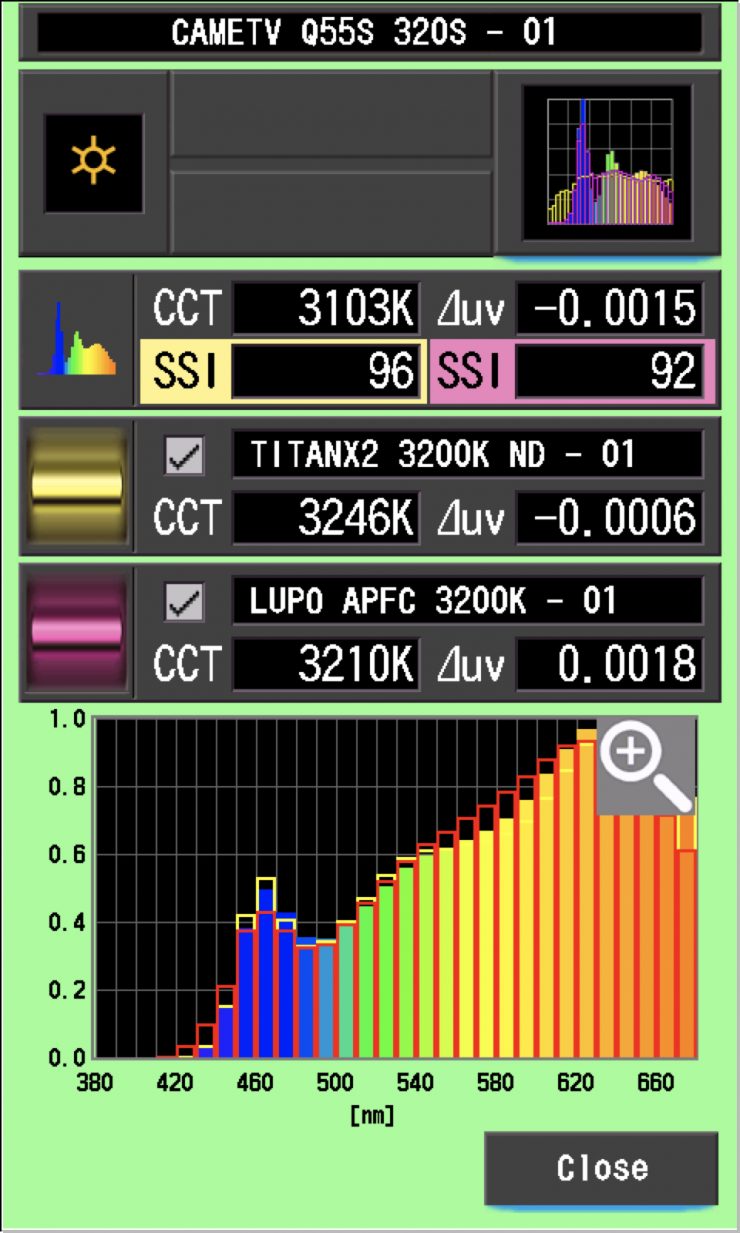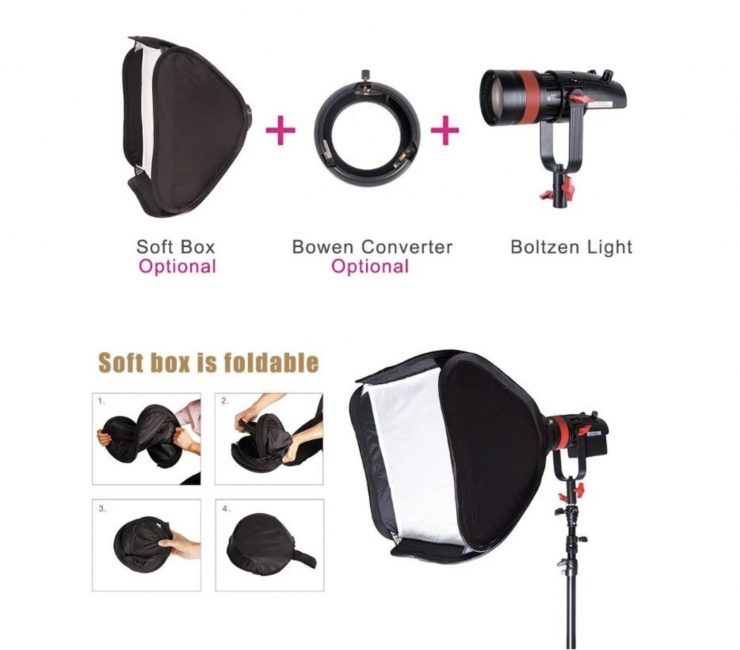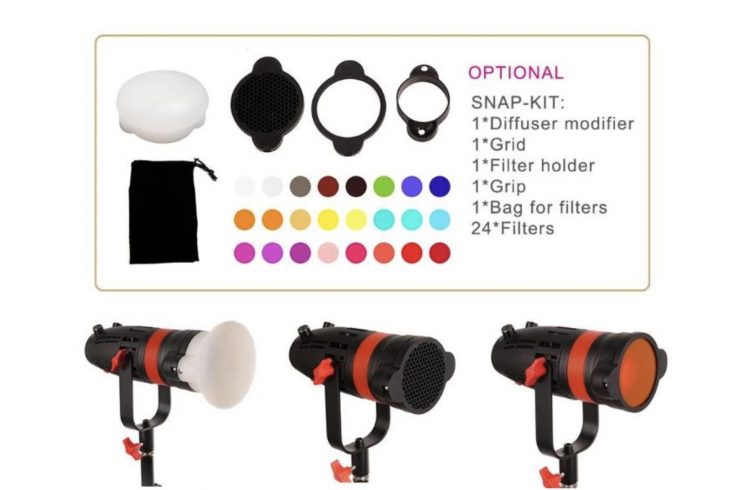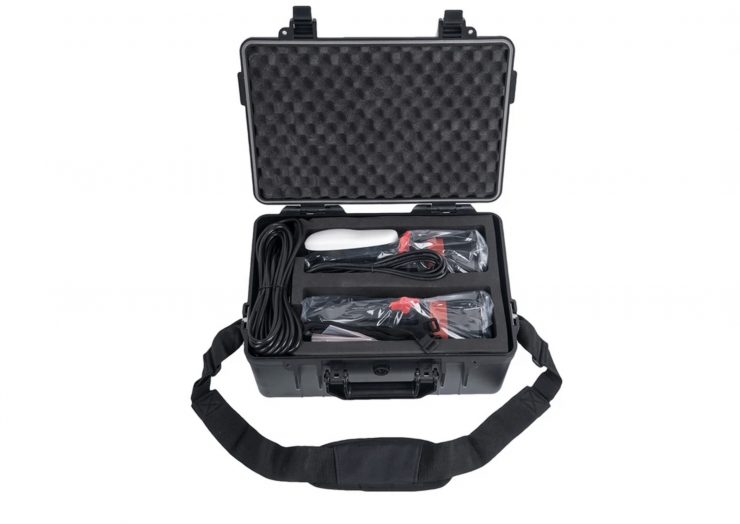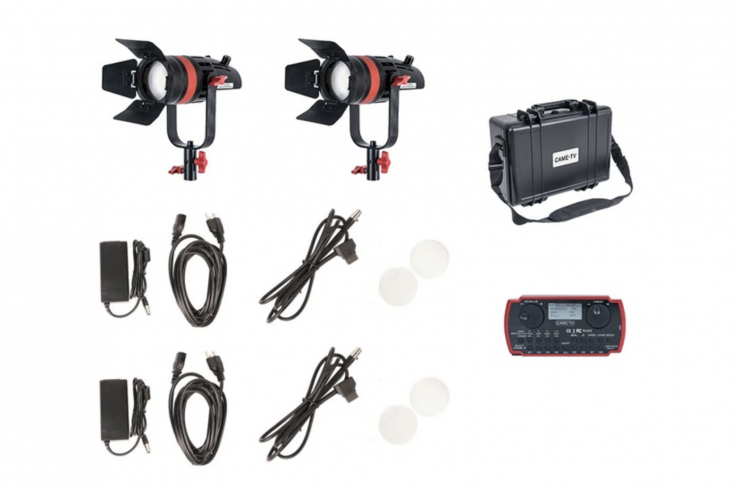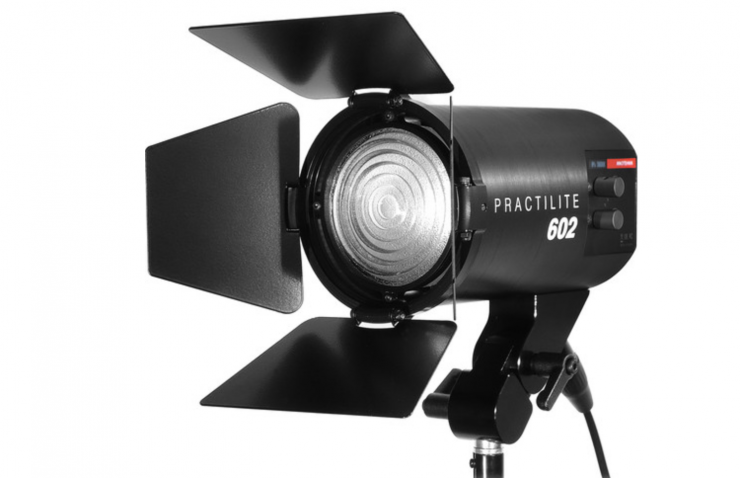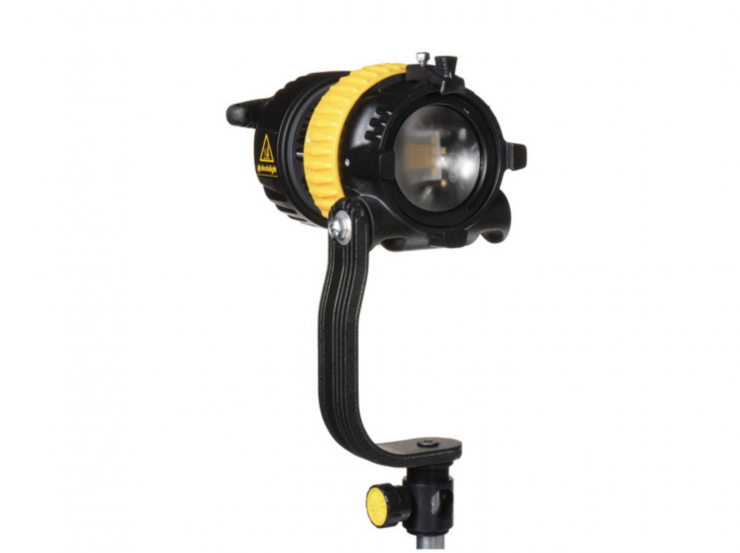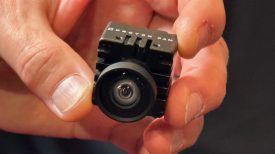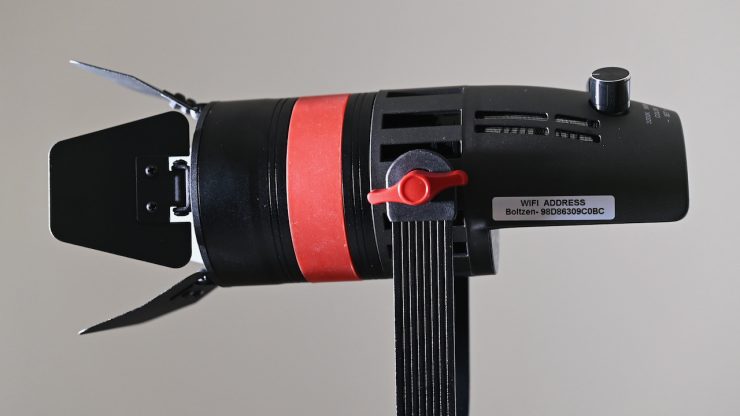
The CAME-TV Q-55S, is an affordable, high output, Bi-color fresnel fixture. For this review, I will be looking at the CAME-TV Q-55S Boltzen Fresnel Kit.
The CAME-TV Q-55S Boltzen Fresnel Kit consists of two Boltzen 55W high output LED lights, a remote Wifi controller, filters, power adapters, and a hard case.
The kit has been designed as a more affordable option to more expensive LED fresnels that are on the market.
This is a new version of the Boltzen 55W lights that I previously reviewed on the site. You can see the review above. CAME-TV looks to have made several improvements to this light.
Key Features
- High CRI (Ra96+)
- Adjustable Frequency
- Color Temperature 3200K – 5600K
- There is 1 LED COB (Chip On Board)
- Built in fan
- Barndoor can easily adjust the lighting direction
- AC Power Adapter included
- Dimming Knob can steplessly adjust the brightness according to users’ need.
- LCD Display Screen
- Can be powered from NP Series batteries or V-Mount Battery
- Filter Set includes Soft and Milky-White filters that can create a specific lighting look.
- Optional Bowens-Mount provides an easy way to mount a softbox and any other studio accessories
Affordable alternative
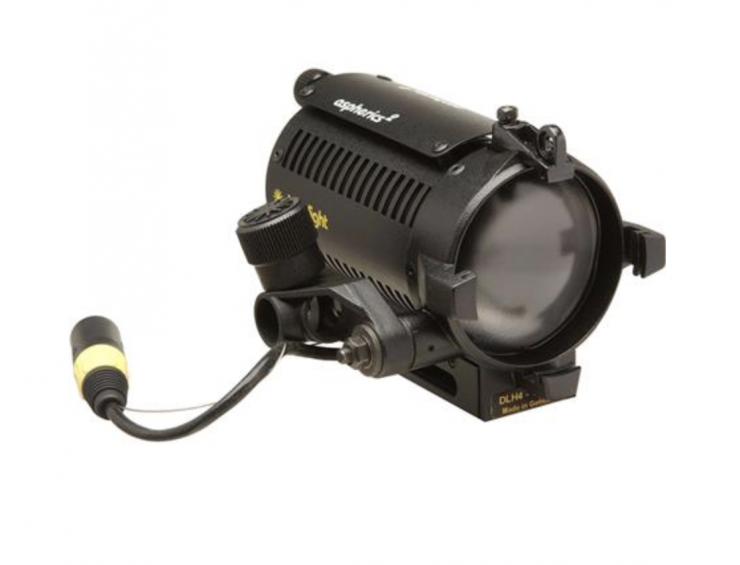
For a long time, it was very difficult to find a decent LED equivalent of the popular Dedolight DLH4 tungsten light. The DLH4 is a workhorse lighting fixture even today and can found in many ENG camera kits. A lot of these lights are more than a decade old and still going strong. They are very versatile and robust, but get very warm and become too hot to touch if you use them for an extended period of time. The DLH4 is able to focus light extremely well thanks to the use of Dedo’s own Aspherics lenses. They also have to run off mains power and for a long time, and they were only available with either a 120v or 240v AC ballast. In short, they have been the compact, hard light source to beat.
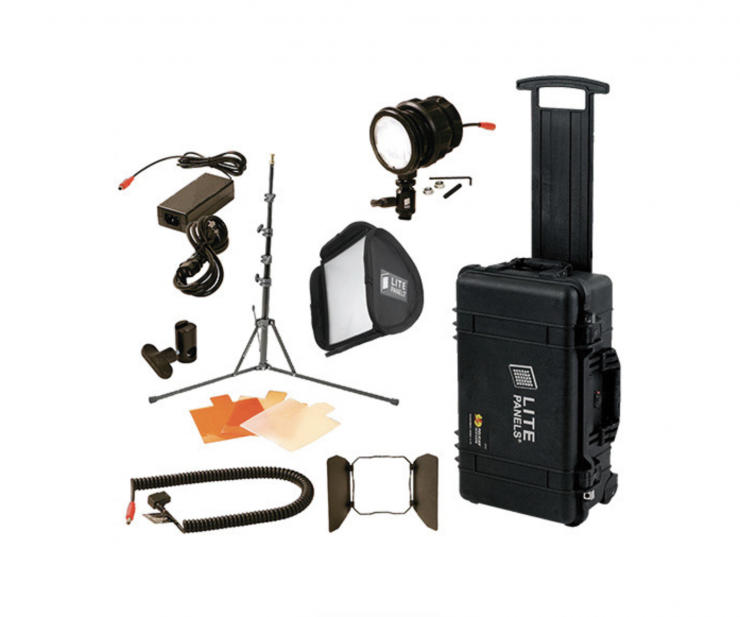
Quite a few companies make LED lights that look similar to the DLH4 from the outside, but a lot of them lacked the output, color accuracy, and light focussing capability. One of these was the Litepanels Sola ENG kit, which I bought back in 2012. I used this kit all over the world as it was very versatile, especially because it could be run off small camera batteries, but it was relatively low powered (by today’s standards) and it was not the most color-accurate of lights. More recently other fresnel style LED lights from companies such as Fiilex and Kinotehnic have appeared that do a much better job than older solutions such as the Sola ENG.
It took a while but Dedo also eventually came out with their own range of LED replacements for the DLH4, including the DLED4.1 and DLED7. I own a set of the Turbo Series DLED7 Bi-Colour 90W lights, and although they are great, they are also very expensive.
I will compare the new CAME-TV Q-55W Boltzen Fresnel Daylight light directly against the Kinotehnic Practilite 602 and the Dedo Turbo Series DLED7 Bi-Colour 90W. Now, both of these lights are considerably more expensive than the CAME-TV, and at first glance, this does seem to be a David v’s Goliath battle. My intention is not to declare a winner, but rather to see the differences between the lights and whether the much cheaper CAME-TV can prove to be a reasonable alternative for those on a budget.
It’s important to remember that these lights by their very design are hard light sources and they will produce strong shadows. They are not designed to be used as a soft key light even though you can add diffusion or attach a soft box. Most shooters would use fresnel style lights like this to light up backgrounds, or when they need to specifically direct and control a light by spotting it up on a small item or area. There are of course other areas where lights like this can also be used to good effect.
Build Quality
The CAME-TV Boltzen 55w is made out of a type of hardened plastic, with some steel. It feels solid in the hand and the on/off and dimmer switches feel well made. The light does have a built in fan and there are large exposed vents all over the back of the fixture.
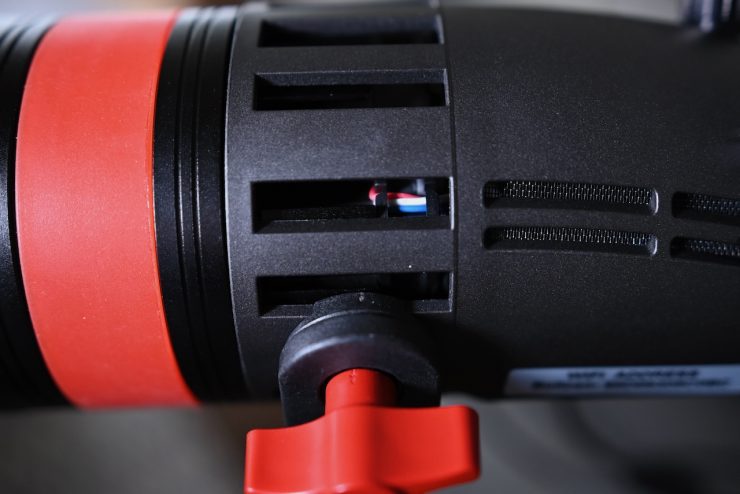
You can see a lot of wires inside and I would be reluctant to use this outdoors in the damp or rain.
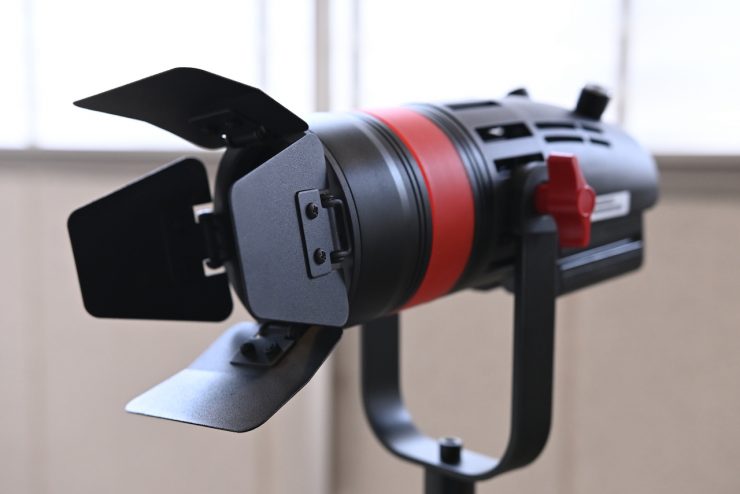
The barn doors are solid but they come permanently attached to a screw in ring that goes onto the front of the light. The Boltzen uses a type of push pull mechanism to focus the fresnel from a flood to spot position. This has a nice amount of resistance to it and feels like it would stand up over time.
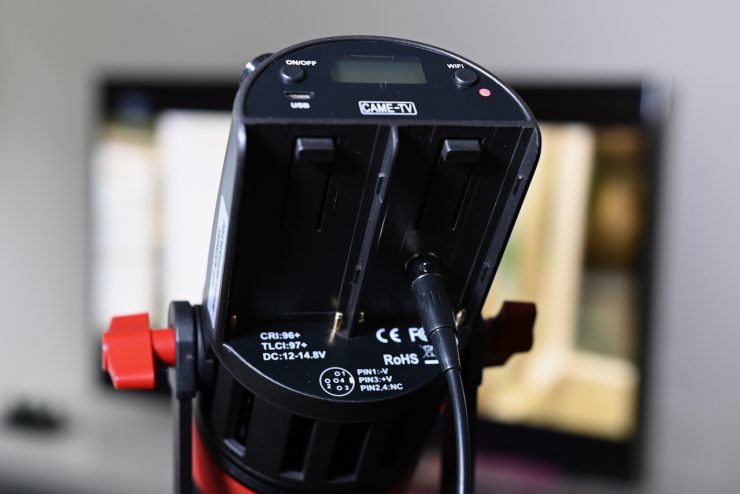
One of the things that does concern me is that the power connector on the light faces straight down, so if you have the light up quite high on a light stand, then all the weight of the power supply ends up being put straight on the connector. I’m not sure how many times you could do this before you risk breaking the cable or connector. This is exactly the same design that was used on the previous model.
The mounting bracket for the light is a lot better than the previous version. It now uses a more robust ratchet-style system and the light locks down correctly.
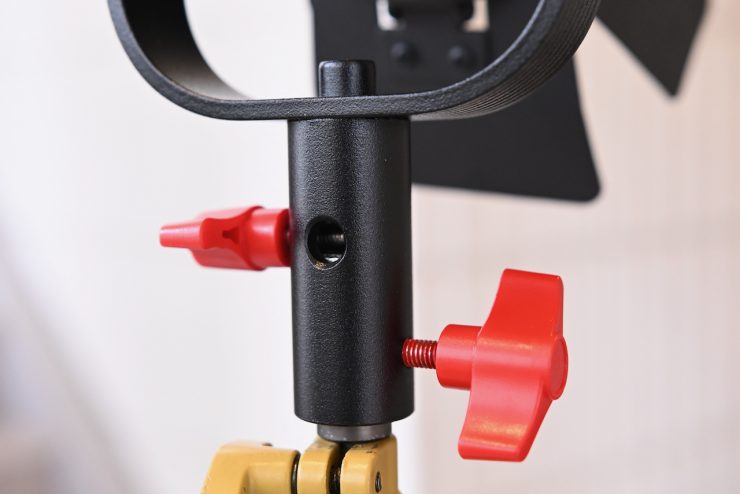
I also like that you can mount the yolk frame both horizontally and vertically to a light stand.
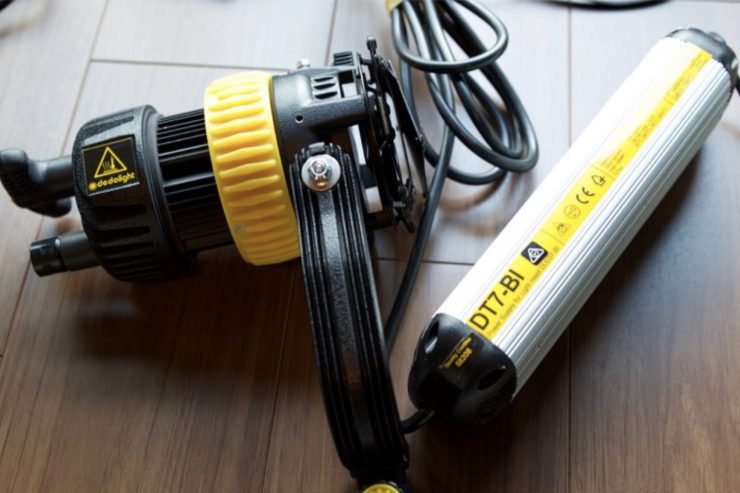
In comparison, the Dedolight DLED7 Bi-Colour head unit and power supply ballast are built like a tank. Just the DLH4, these LED fixtures are designed and manufactured to stand the test of time. The light feels heavy and incredibly solid and there are no exposed vents. You can’t see any of the wiring or internals of the fixture from the outside. Everything about the light screams quality. The ballast is also super strong and well made and features the nice touch of having an adjustable loop so you can hang it off a light stand.
The DLED7 has a safety protection class III, SELV, and IP20 rating. This means it is not protected from any type of liquids, so you really shouldn’t be using it outdoors in moisture, rain or snow.
The Kinotehnic Practilite 602 is very well made. In an age where more and more products feel cheaply made and not designed to stand the test of time, Kinotehnik has done a very good job with this fixture. The light is housed in full CNC-machined aircraft-grade aluminum. It feels solid in the hand and the mounting point where you attach the light to a light stand or arm is one of the most robust I have come across.
Size & Weight
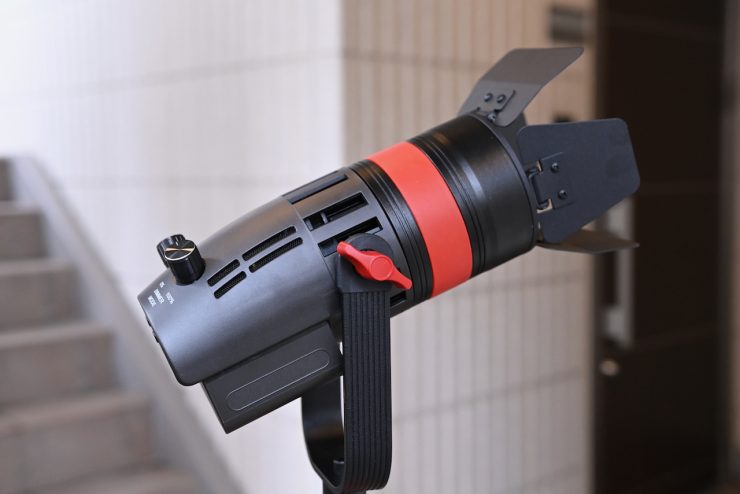
The CAME-TV fixture weighs in at 1.05 kg (2.3 lb) and it has physical dimensions of 30.5 cm (12″) x 9 cm (3.5″). These measurements include the yolk frame.
Below you can see how that compares to the Dedo and Kinotehnik.
| WEIGHT | |
| CAME-TV 55W | 1.05 kg (2.3 lb) |
| Kinotehnik Practilite 602 | 1.3 kg (2.9lbs) |
| Dedo Turbo Series DLED7 Bi-Colour 90W | 1.3 kg (2.9 lb) 2.7 kg with the power ballast |
Design & Operation
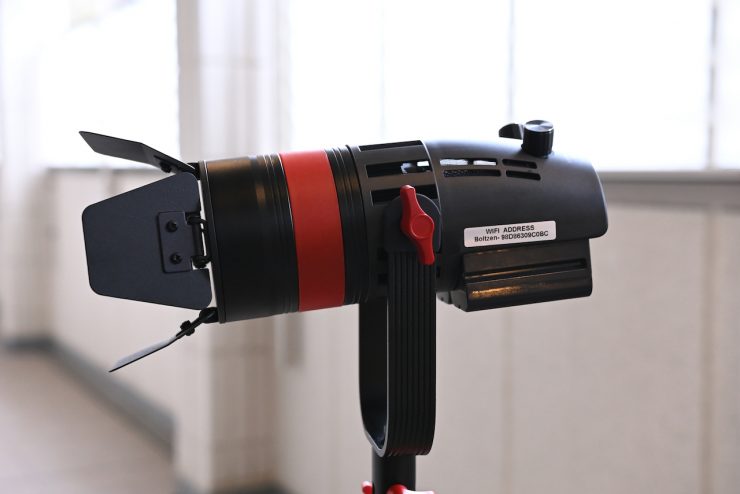
The CAME-TV Boltzen 55W doesn’t operate in exactly the same way as a traditional fresnel light, but the results are the same. With most fresnel lights the reflector/lamp tray moves forwards and backward away or towards the lens. As the lamp (with its reflector) is moved towards the lens, the beam becomes wider, and as it moves away from the lens, the beam becomes narrower. With the Boltzen however, the LED element stays still and the lens is moved forwards or backward. This is intended to accomplish the same idea in a slightly different way. Overall the spot and flood functions still work well
One of the most unique things about the Boltzen 55W is that you can actually remove the lens that sits in front of the LED element. When used without the lens, the light allows for a far wider flood than you can achieve with it in. If you want to control the spill when using the light this way you can use the barn doors. You do however lose a lot of the intensity of the light as the LED is having to spread the light over a much further area than usual. Despite this, it does make the light quite versatile and it allows you to use it for other purposes.
Both the Dedo and Kinotehnik use fresnel lenses that are made out of Borosilicate glass, and not acrylic or plastic-like the CAME-TV. Borosilicate glasses are known for having very low coefficients of thermal expansion, making them resistant to thermal shock, more so than any other common glass. Borosilicate glass also allows for increased light transmittance through the lens when compared to plastics and lower-quality glass.
Kelvin color temperature range
The CAME-TV fixture is Kelvin color temperature adjustable between 3200-5600K. The Dedo is adjustable between 2700-6500K and the Kinotehnik can go between 3000-6000K.
How do you power them?
The CAME-TV Boltzen 55w lights can be powered via AC (with included power adapter), NP Series batteries, or from a larger battery through a D-tap cable.
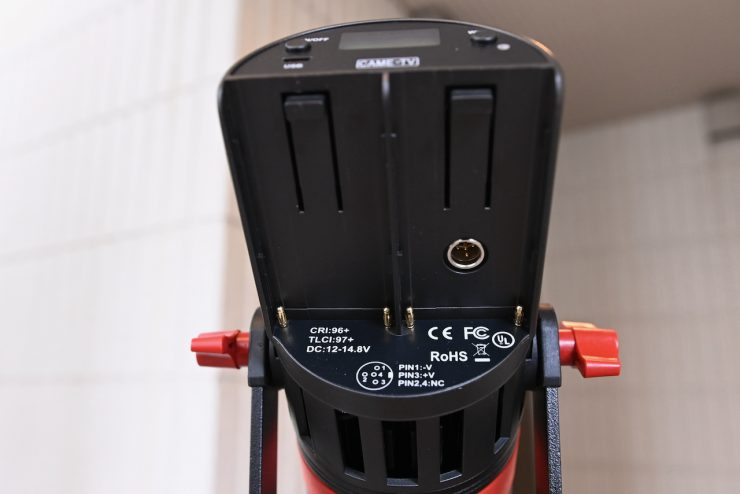
Unlike the previous version, the new light now comes with two battery slots. Now, despite only drawing 55W I found that I had to have two NP batteries attached to power the light.
CAME-TV claims that two NP F970 batteries will power the light at full strength for around 90 minutes. From my testing I found that figure to be reasonably accurate.
Having an NP battery is a nice option and it makes the light a very attractive prospect for solo shooters and small crews that may be shooting in locations where mains power is not an option.
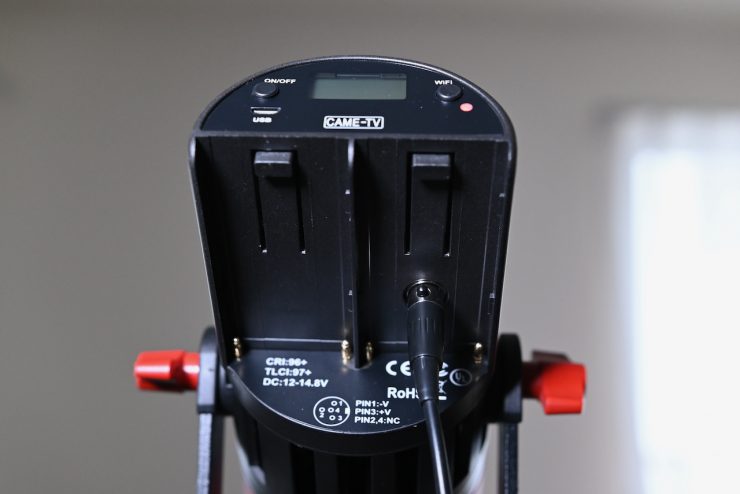
I still don’t like how the power connector faces straight down. If you don’t secure the cable and give it some slack, the power supply puts all the weight on the connector. I wish CAME-TV had changed this part of the design. In saying that, at least the new version doesn’t flicker if you pull on the power cable or connector.
Below you can see a power draw comparison between the Dedo and Kinotehnic.
| POWER DRAW | |
| CAME-TV 55W | 55W |
| Kinotehnic Practilite 602 | 85W |
| Dedo DLED7 | 90W |
The Kinotehnic and Dedo use a very secure and robust 4-pin and 6-pin XLR power connectors that securely lock into place. These are professional connectors that are a lot more robust than the system being used on the CAME-TV.
Control Interface
The CAME-TV uses a simple interface that includes a small LED screen, an on/off button, Wifi button, and dials to adjust the Kelvin color temperature and intensity.
The Kelvin color temperature can be adjusted in increments of 50K, while the intensity can be adjusted in 1% increments.
The operation of the light is fairly straight forward and easy to do.
WiFi
The light has built-in Wifi which is an improvement over the older model. The kit that I was testing comes with a WiFi controller that looks like it belongs to a 1980’s Nintendo system.
Despite its almost vintage look, it is functional and it does make controlling the CAME-TV fixtures fairly easy. Carrying around a large remote controller in 2020 is not something most people probably want to do.
Strangely (and this isn’t listed anywhere in the manual) you can just download the Boltzen App and connect to the WiFi network that the light creates.
Here you can use the app to control your lights instead of having to use the remote controller. You can group lights and make changes to multiple lights or to just one light. You can adjust the color temperature and intensity as well as turn on/off the lights. There is also a timer feature where you can set the light to turn on at a certain time and then have it turn off automatically.
I found that using the app made a lot more sense than using the remote controller.
Beam Angle
The light has an adjustable beam angle of 20-60°, which is not a lot for a fresnel fixture. You adjust the beam angle by pushing out or pulling in the front of the fixture.
If you need more control you need to use the barn doors. As I mentioned earlier you can take the front acrylic element out, but then you are left with a bare COB element. While this does increase the beam spread, you don’t want anyone looking straight into a COB element.
| WEIGHT | |
| CAME-TV 55W | 20-60° |
| Kinotehnic Practilite 602 | 15-75° |
| Dedo DLED7 | 4-60° |
Above you can see a comparison against the Dedo and Kinotehnik when it comes to beam angles. Both the Kinotehnik and Dedo have a far better beam range.
Built-in fan
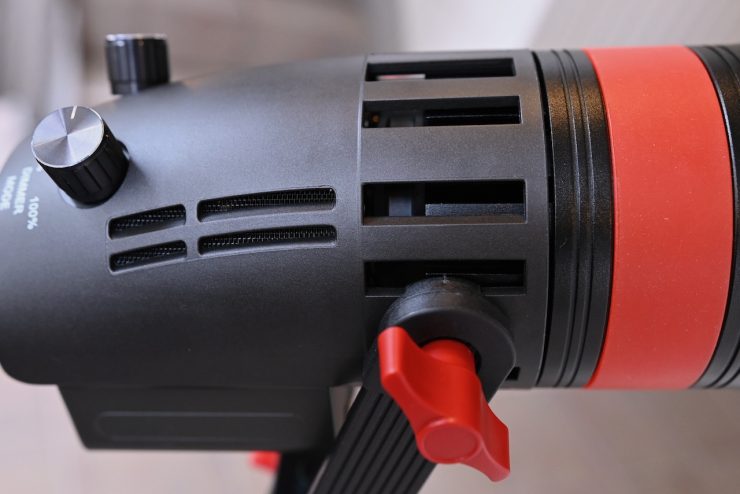
There is a built-in cooling fan to dissipate heat. The fan is relatively quiet and you would struggle to hear it even in a quiet room.
The light does get very hot quickly, especially towards the front. This is a problem because if you want to adjust the beam angle you need to place your hands on a very hot section of the light.
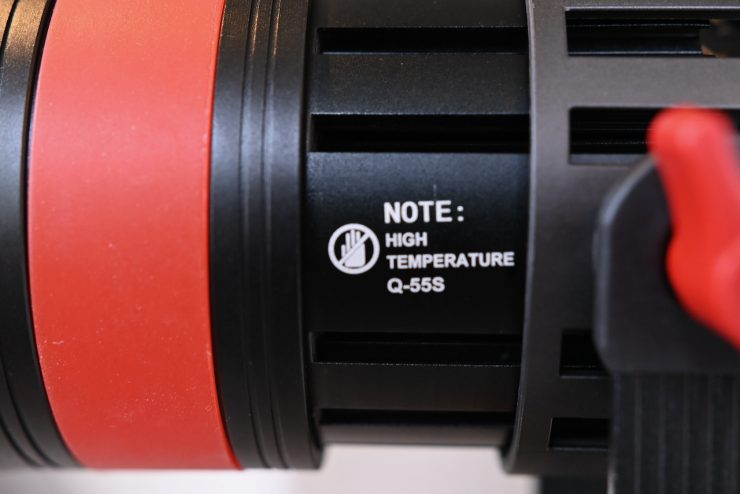
In fact, there is even a heat warning sticker that you can see when the light is in its full spot position.
In my opinion, the light gets way too hot and this makes me apprehensive about how much life you would get out of the fixture before it fails.
The Kinotehnic feature an in-built fan that is always on (although it’s barely audible). The Dedo features Active Silent Cooling and it doesn’t have a fan.
Neither the Kinotehnic or the Dedo get particularly hot.
Effects
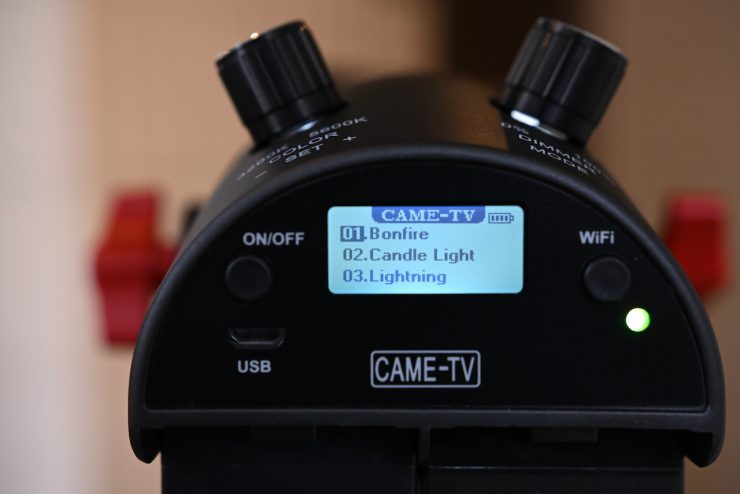
CAME-TV has included several effects in the 55W Boltzen. This is nice to see in an affordable fresnel LED fixture. The effects that are in there are:
- Bonfire
- Candle Light
- Lightning
- 5600K Breath
- 3200K Breath
- 3200-5600K Transition
You can only seem to adjust these parameters using the WiFi controller.
Frequency Setting
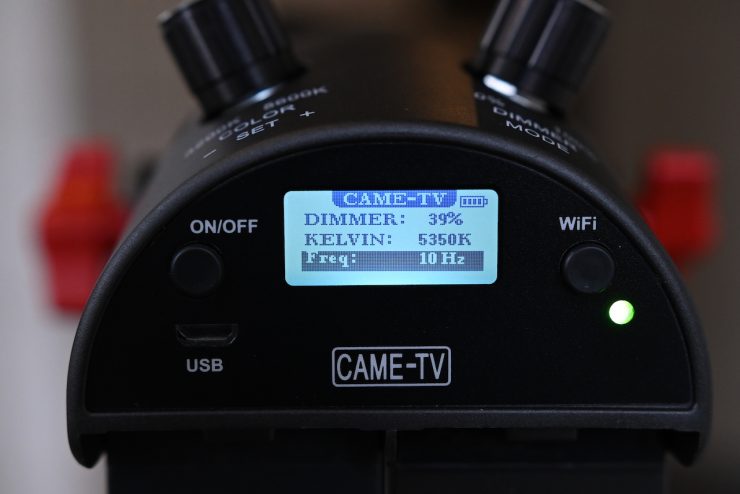
There is a setting to adjust the frequency on the light if you want it to strobe. This can be adjusted from 0Hz to 10Hz.
It is handy to have this feature, but it is not something most people are going to use very often.
Photometrics
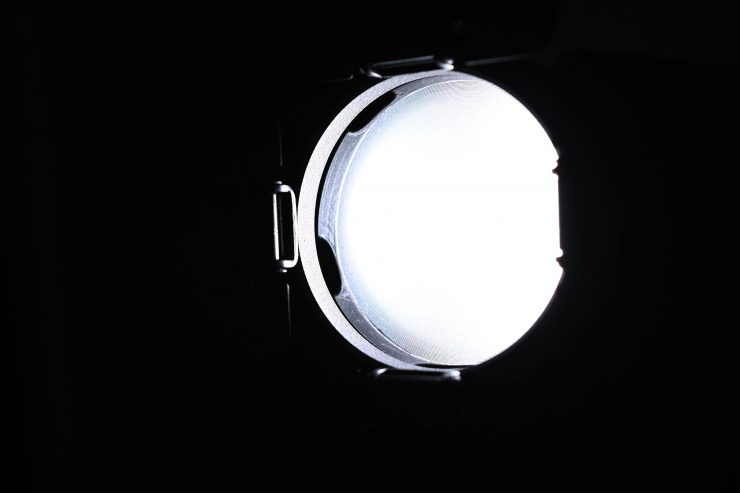
So now let’s get to the photometric results. I always test lights in this way so that I get a reference to how they compare to other fixtures. Results only tell part of the story and should never be used alone to judge a light. I have found from extensive testing over the years that certain lights that have good photometric results don’t always look good, and lights that have worse photometric scores can sometimes look better than their results indicate.
Output & Kelvin Color Temperature Accuracy
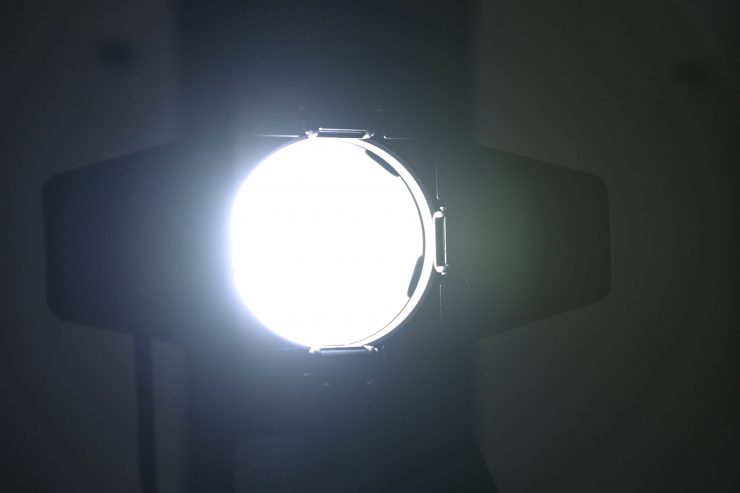
I tested the CAME-TV Q-55S Boltzen Fresnel at a variety of Kelvin color temperatures in both its flood and spot positions with a Sekonic C-800 Spectrometer to find out how much output the light had and how accurate the Kelvin color temperature reproduction was. All readings are taken at a distance of 1m (3.28ft) in a controlled environment.
5600K
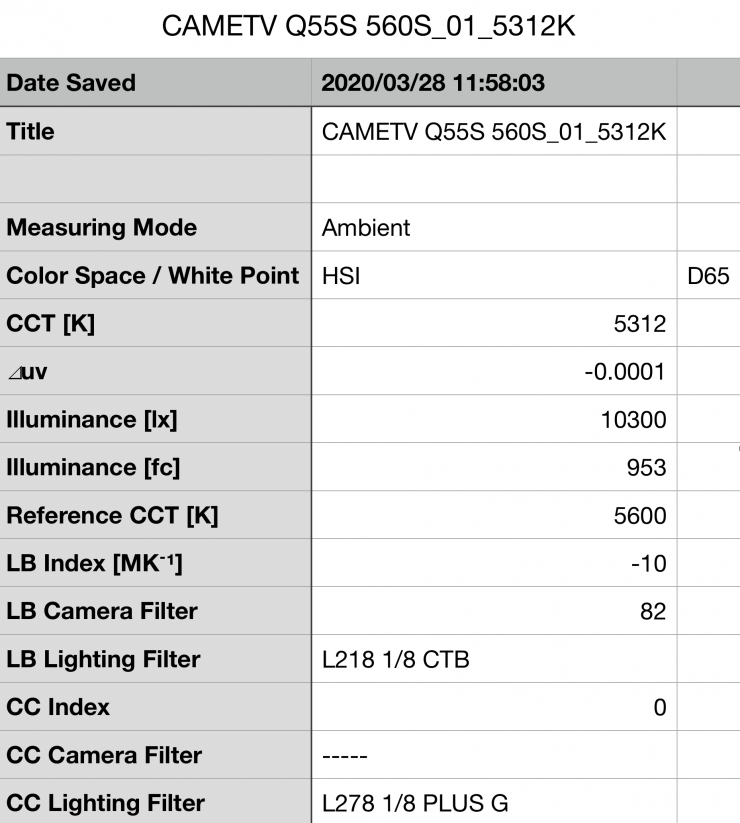
Above you can see the CAME-TV recorded an output of 10,300 lx 953 (fc) when set at 5600K and used at 20 degrees and run off mains power. This output was reasonably good for a fixture of this size that only draws 55 watts.
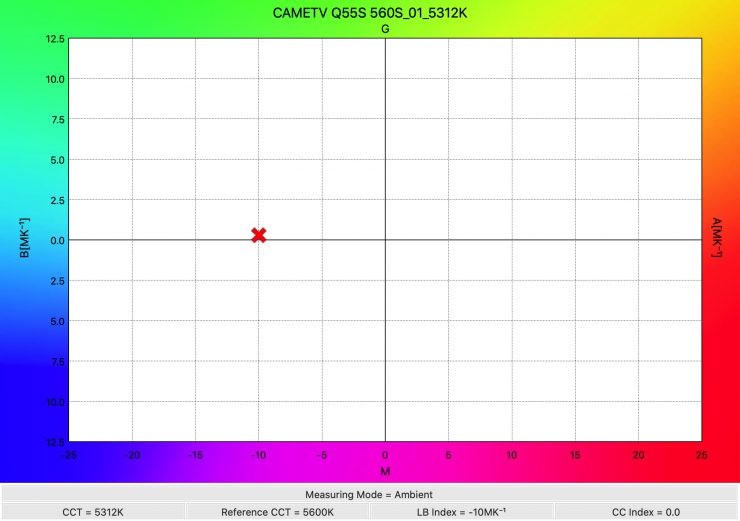
The CAME-TV produced a Kelvin color temperature of 5312K. It had a CC Index score of 0. The 5312K reading was a lower than what I would have liked to have seen when using this light at 5600K.
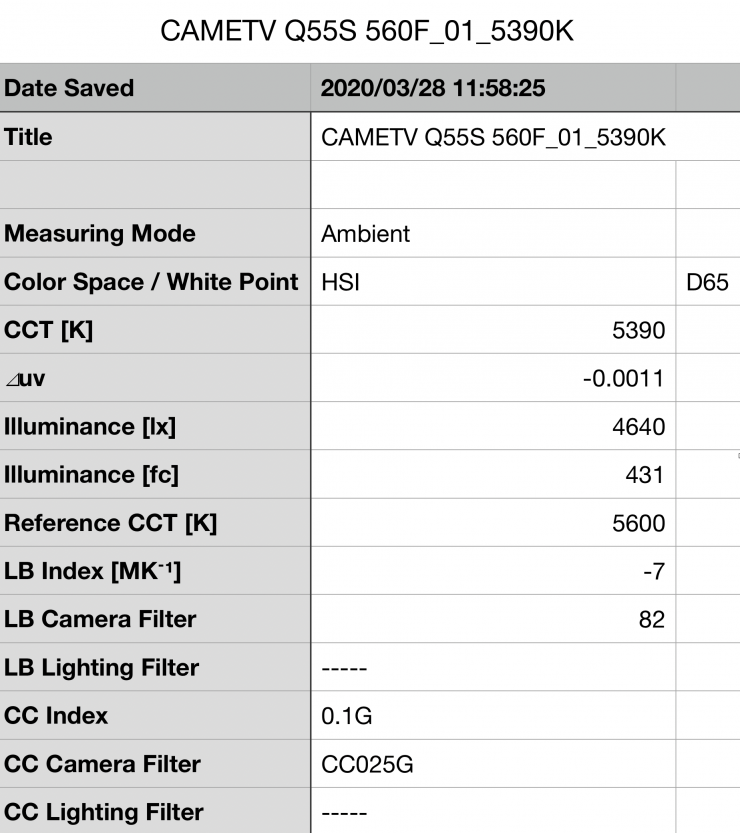
Above you can see the light recorded an output of 4,640 lx 431 (fc) when set at 5600K, flooded to 60 degrees, and run off mains power.
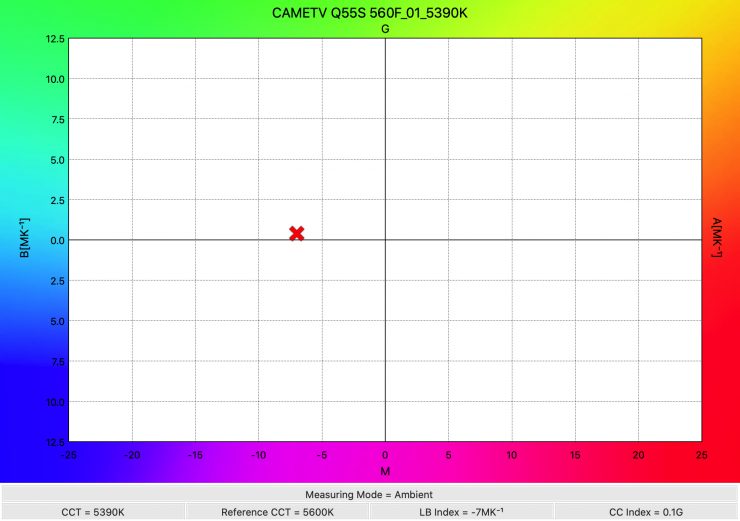
The light produced a Kelvin color temperature of 56390K, which was slightly higher than when it was used in its full spot position. What was also interesting is that the light recorded a CC Index score of 0.1G.
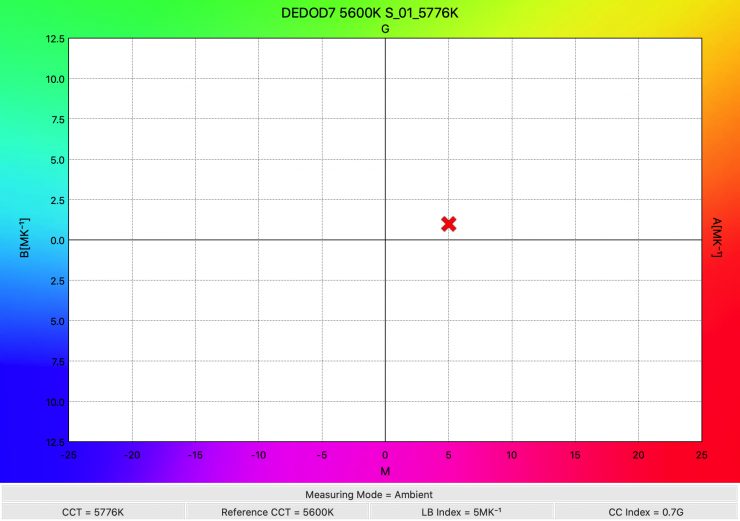
Dedo Turbo Series DLED7 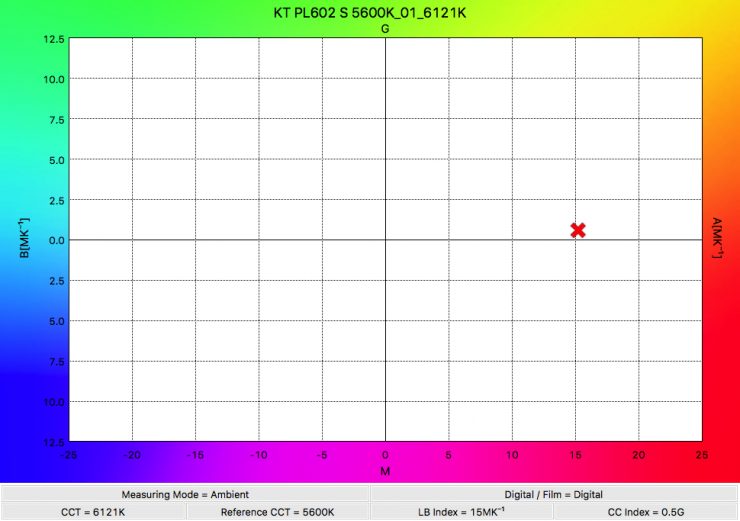
Kinotehnic Pracilite 602
As a comparison here are the white balance charts for the Dedo and Kinotehnik.
So how does that compare to the KInotehnic Practilite 602 and the Dedo Turbo Series DLED7 Bi-Colour 90W? I have previously recorded data from both of these fixtures. Below you can see the results:
| OUTPUT (Spot) | KELVIN COLOR TEMP | CC INDEX | |
| CAME-TV 55W | 10,300 lx | 5312K | 0 |
| Kinotehnic Pracilite 602 | 10,600 lx | 6121K | 0.5G |
| Dedo Turbo Series DLED7 | 20,200 lx | 5776K | 0.7G |
| OUTPUT (Flood) | KELVIN COLOR TEMP | CC INDEX | |
| CAME-TV 55W | 4640 lx | 5390K | 0.1G |
| Kinotehnic Pracilite 602 | 2830 lx | 6256K | 0.6G |
| Dedo Turbo Series DLED7 | 3010 lx | 5634K | 0.8G |
From my testing at 5600K the CAME-TV was more Kelvin color-accurate than the Dedo or Kinotehnik. As far as output is concerned, it is a little hard to compare the lights because the beam angles are all different. However, the CAME-TV does have a good amount of output considering its power draw.
3200K
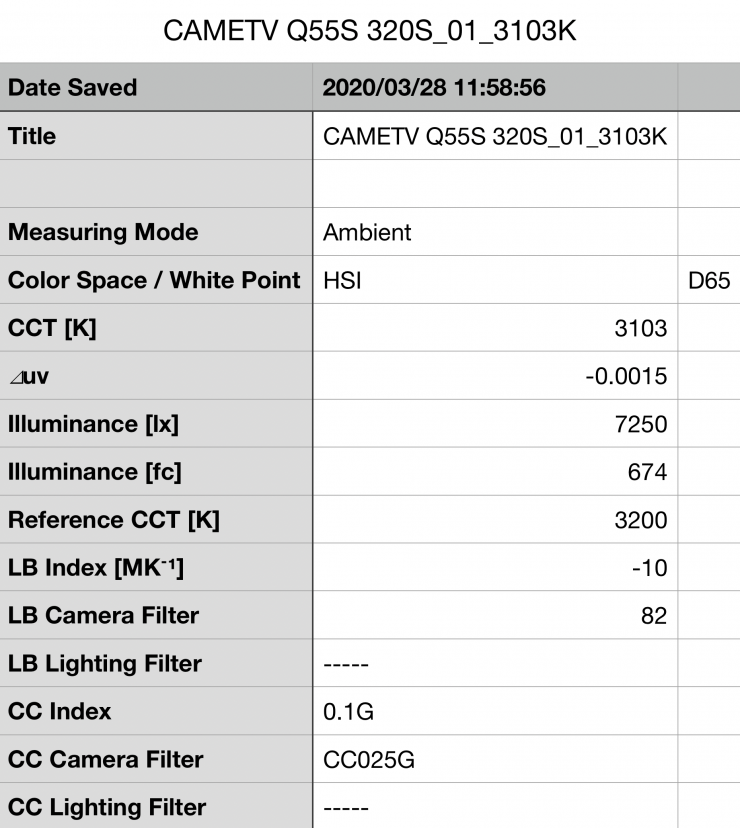
Above you can see the CAME-TV recorded an output of 7250 lx 674 (fc) when set at 3200K, used at 20 degrees, and run off mains power. This was 29.6% less output than when the light is used at 5600K.
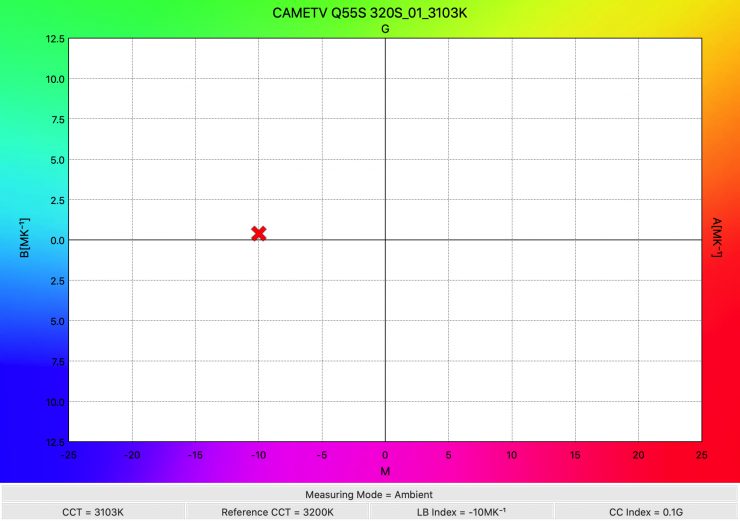
The light produced a Kelvin color temperature of 3103K. The fixture had a 0.1G CC Index score.
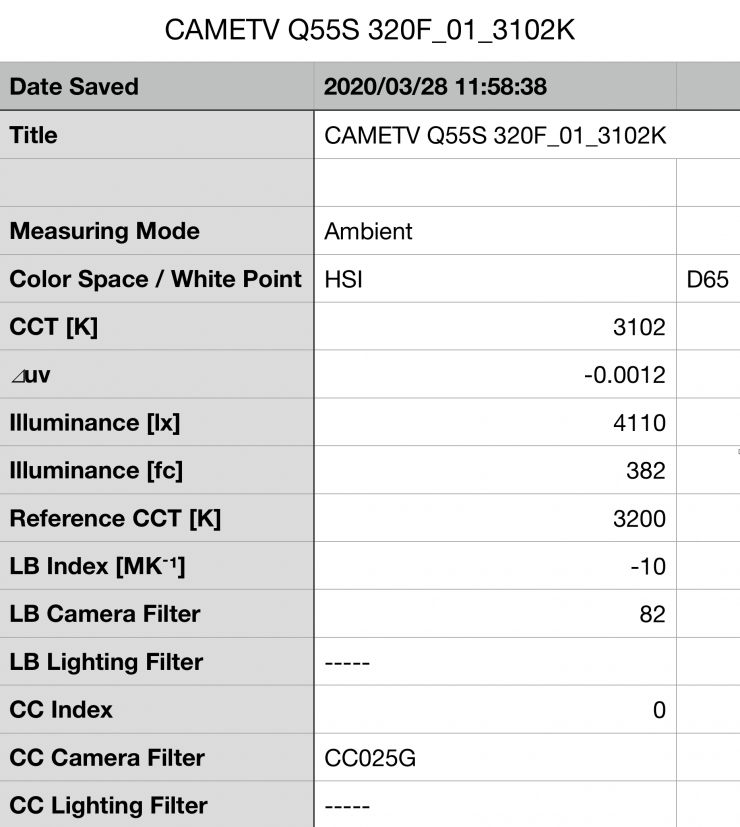
Above you can see the CAME-TV recorded an output of 4110 lx 382 (fc) when set at 3200K, used at 60 degrees, and run off mains power.
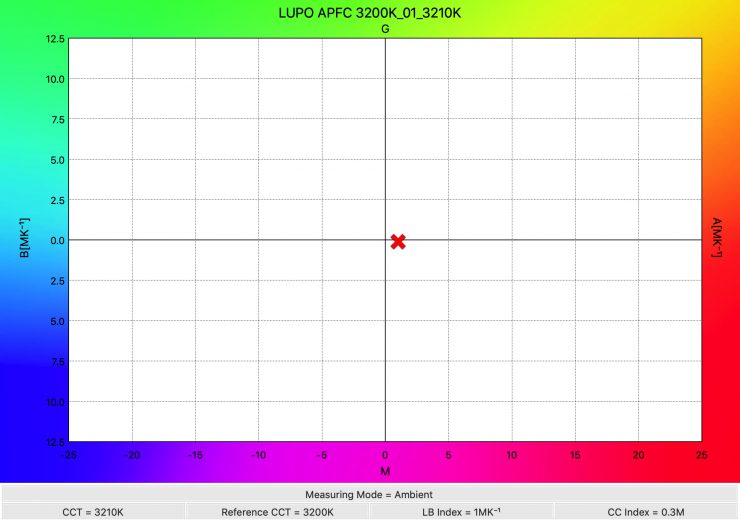
The light produced a Kelvin color temperature of 3102K. The fixture had a 0 CC Index score.
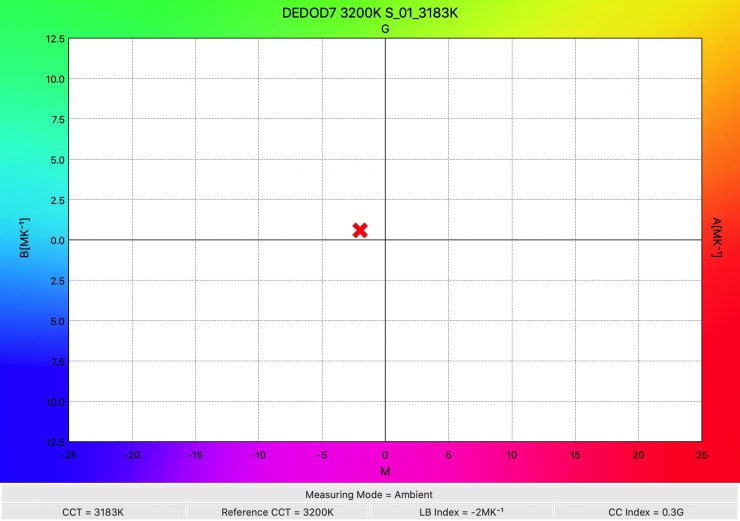
Dedo Turbo Series DLED7 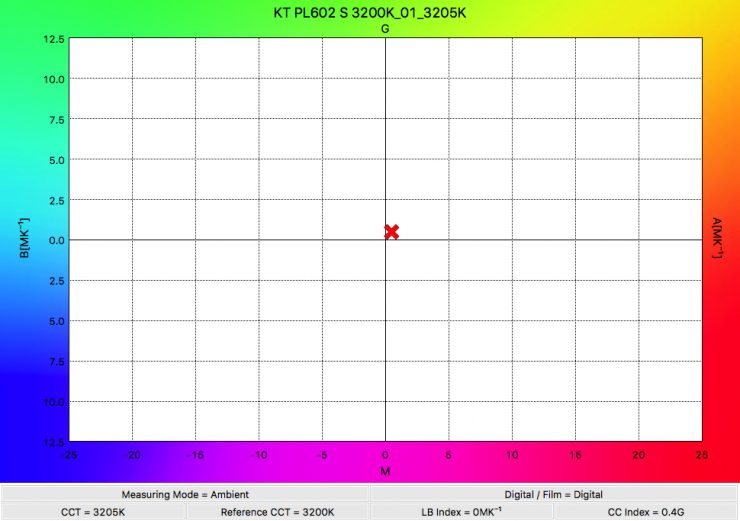
Kinotehnic Pracilite 602
As a comparison, above you can see the white balance charts for the Kinotehnik and the Dedo.
| OUTPUT (Spot) | KELVIN COLOR TEMP | CC INDEX | |
| CAME-TV 55W | 7250 lx | 3103K | 0.1G |
| Kinotehnic Pracilite 602 | 10,400 lx | 3205K | 0.4G |
| Dedo Turbo Series DLED7 | 17,400 lx | 3183K | 0.3G |
| OUTPUT (Flood) | KELVIN COLOR TEMP | CC INDEX | |
| CAME-TV 55W | 4110 lx | 3102K | 0 |
| Kinotehnic Pracilite 602 | 3090 lx | 3222K | 0.5G |
| Dedo Turbo Series DLED7 | 2670 lx | 3126K | 0.4G |
Above you can see how these figures compare to the Kinotehnic Practilite 602 and the Dedo Turbo Series DLED7 Bi-Colour 90W.
From my testing, I found that the Kinotehnic and Dedo don’t have a huge output loss when you go from 3200K to 5600K. They are also slightly more Kelvin color accurate, but not by a big margin.
Summary of output and Kelvin color temperature results of CAME-TV in both Spot And Flood (all results recorded at a distance of 1 meter):
SPOT
| LUX | FC | Kelvin Color Temperature | |
| 3200K | 7250 lx | 674 fc | 3103K |
| 4500K | 8930 lx | 829 fc | 4215K |
| 5600K | 10,300 lx | 953 fc | 5312K |
FLOOD
| LUX | FC | Kelvin Color Temperature | |
| 3200K | 4110 lx | 382 fc | 3102K |
| 4500K | 3910 lx | 364 fc | 4200K |
| 5600K | 4640 lx | 431 fc | 5390K |
These results show me that the light drops output when you start moving the Kelvin temperature dial down from 5600K. The Kelvin color temperate accuracy of the light could be better when it is used above 3200K. But, overall, the results were impressive for an affordable LED fresnel.
Color Rendering
So now that we have seen how much output the CAME-TV produces, how does it perform when it comes to replicating accurate colors. Well, let’s find out.
5600K
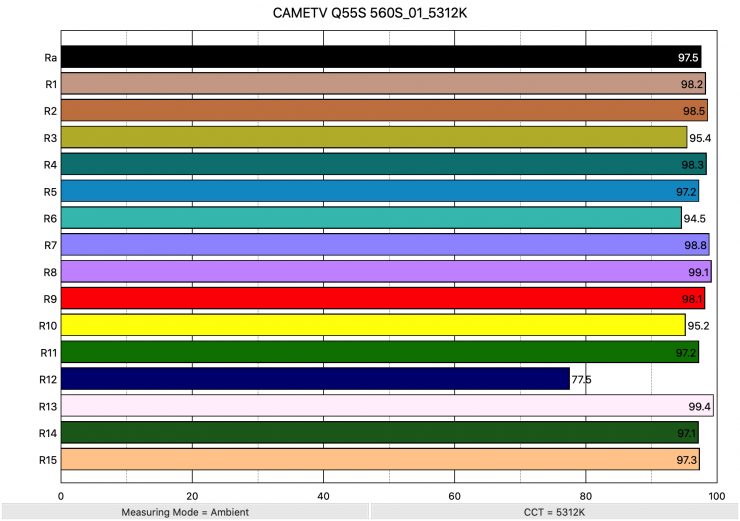
Above you can see that when the Dual Color was set at 5600K it recorded an average CRI (R1-R8) of 97.5 and an extended CRI (R1-R15) of 96.12. For replicating accurate skin tones it recorded 98.1 for R9 (red), 99.4 for R13 (closest to caucasian skin tones), and 97.3 for R15 (closest to Asian skin tones). These were excellent results and some of the best I have seen from an LED fixture.
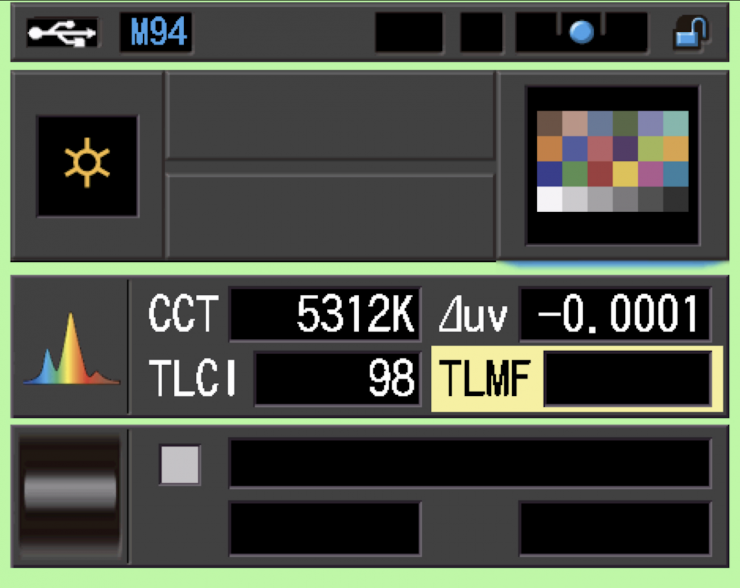
The light when set at 5600K also recorded a TLCI score of 98.
3200K
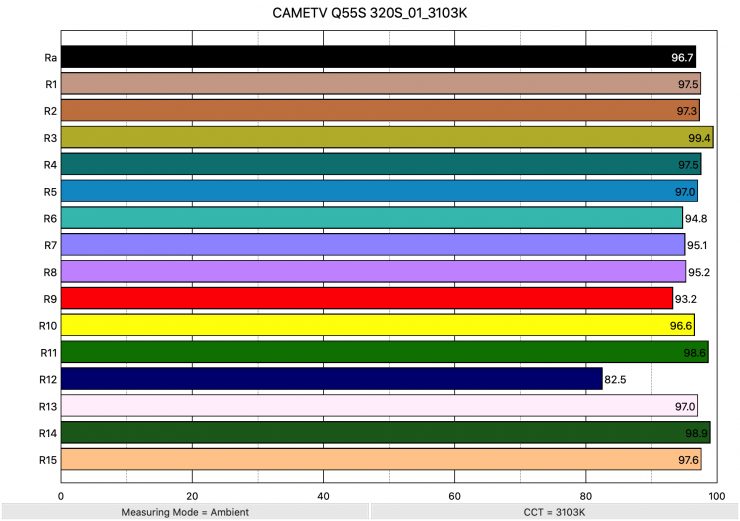
Above you can see that when the light was set at 3200K it recorded an average CRI (R1-R8) of 96.7 and an extended CRI (R1-R15) of 95.88. For replicating accurate skin tones it recorded 93.21 for R9 (red), 97 for R13 (closest to caucasian skin tones), and 97.6 for R15 (closest to Asian skin tones). These results were again very good, although, not quite as good as when the light was used at 5600K.
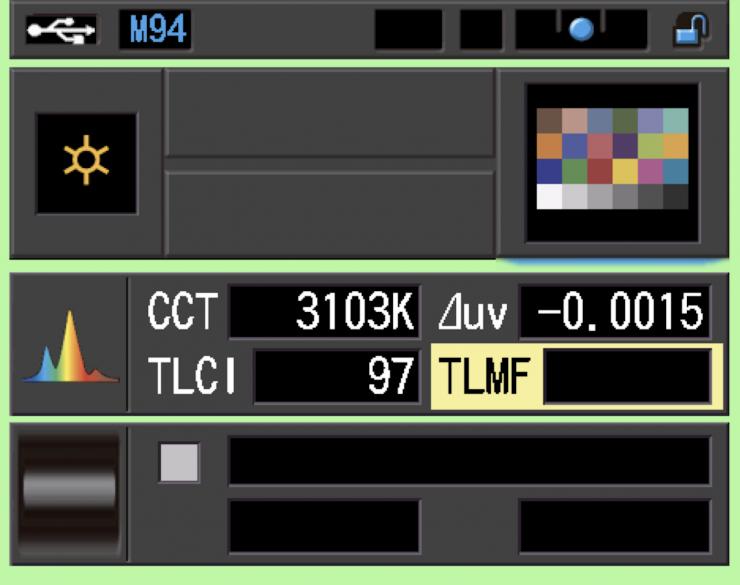
The light when set at 3200K also recorded a TLCI score of 97.
So how do these results compare to the Kinotehnic Practilite 602 and the Dedo Turbo Series DLED7 Bi-Colour 90W? Below you can see comparison tables.
5600K
| AVERAGE CRI | EXTENDED CRI | |
| CAME-TV Boltzen 55W | 97.5 | 96.12 |
| Kinotehnic Practilite 602 | 92.5 | 90.4 |
| Dedo Turbo Series DLED7 | 94.2 | 91.46 |
3200K
| AVERAGE CRI | EXTENDED CRI | |
| CAME-TV Boltzen 55W | 96.7 | 95.28 |
| Kinotehnic Practilite 602 | 97.2 | 96.21 |
| Dedo Turbo Series DLED7 | 97.3 | 96.34 |
As you can see, all three lights have quite similar scores. What surprised me was that the CAME-TV had better color rendering at 5600K than the Dedo or Kinotehnik.
It was impressive to see that the CAME-TV was on par with a lot more expensive fixtures.
SSI
SSI (Spectral Similarity Index) was developed by the Sci-Tech Council of the Academy. SSI gives me the ability to set any light as a standard, or use predefined standards (such as CIE D55), and then give other lights an SSI score based upon how well they will match standards such as CIE D55 measure spectral response and compare it directly against an ideal light source.
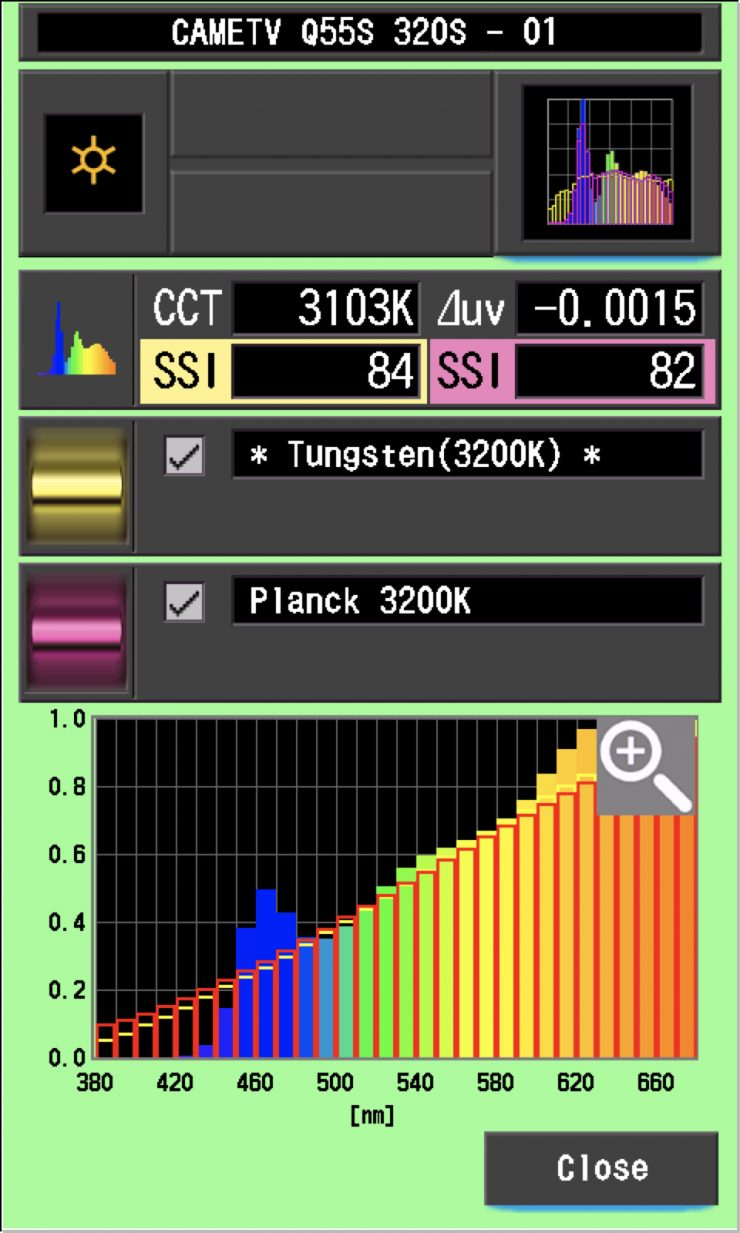
In this graph the Gold bars indicate a perfect 3200 (Tungsten source. The Red bars indicate a Planck 3200K source. This lets us compare how close to a perfect 3200k lighting source the CAME-TV is. A score in the low to mid-80s is very good for a 3200K LED light.
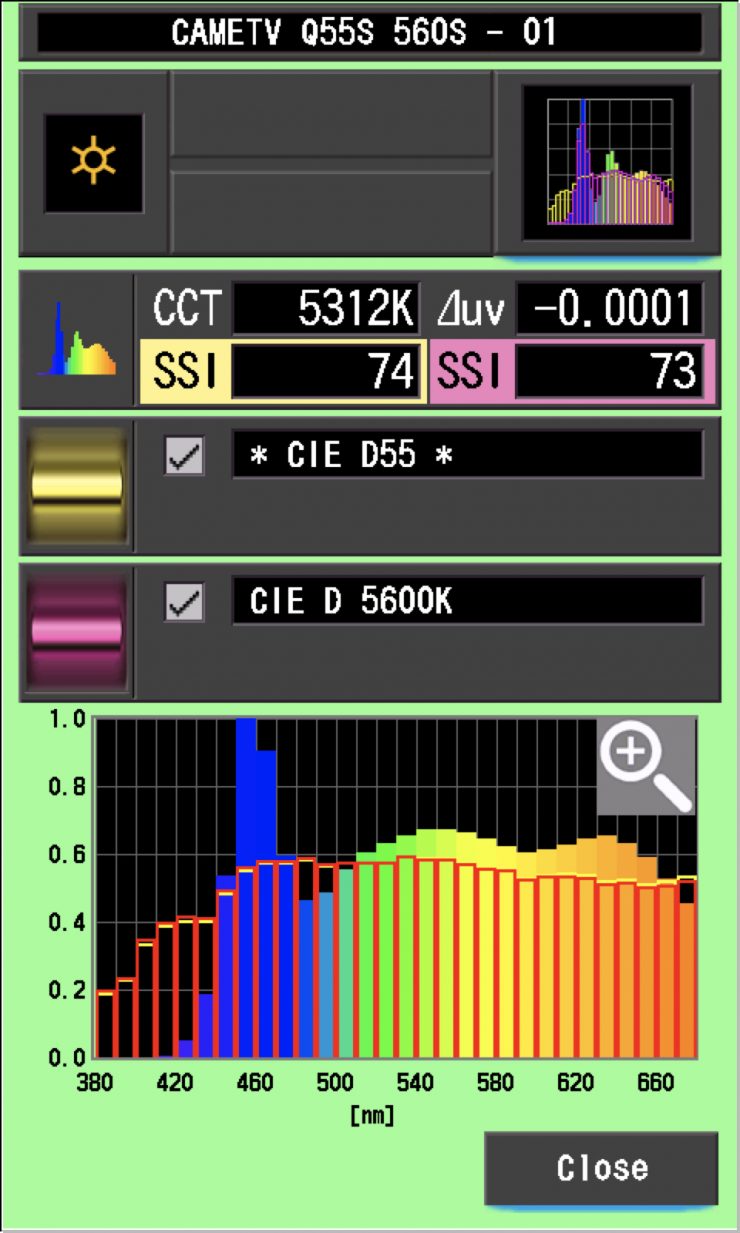
In this graph above the gold bars indicate a perfect D55 source. The Red bars indicate a 5600K source. This lets us compare how close to a perfect 3200k lighting source the Lupo is. A score in the low 70’s is very common for most 5600K LED sources.
The main reason we want to record SSI scores is so we can see how well they match with other lights. As a test, I thought I would see how well it would work alongside a Rotolight Titan X2. and a Lupo Actionpanel Full Color.
At 5600K, the CAME-TV works better with the Rotolight than it does with the Lupo. At 3200K the light is a better match to both the Lupo and Rotolight. For instance, based on this test I now know that I could use the Rotolight Titan X2 at 3200K alongside the CAME-TV and they would match pretty well.
Spectral Distribution
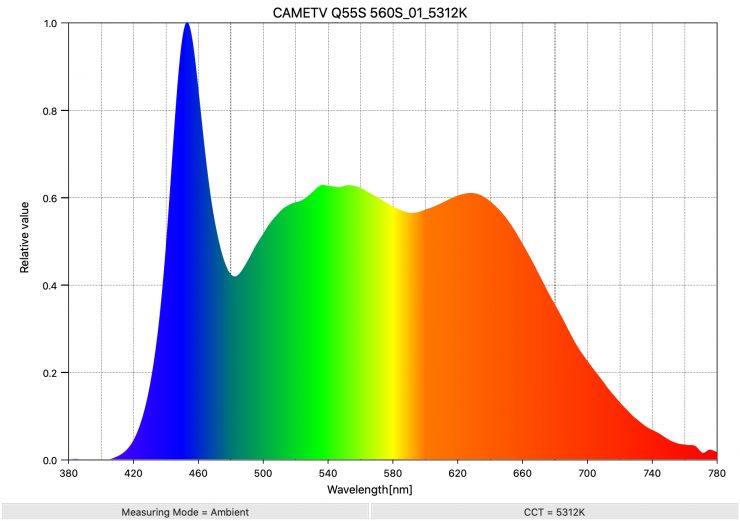
Above you can see the spectral distribution of the CAME-TV when it is set at 5600K. The spectral distribution is fairly good at 5600K. This spectral distribution is fairly common for a lot of LED lights at 5600K.
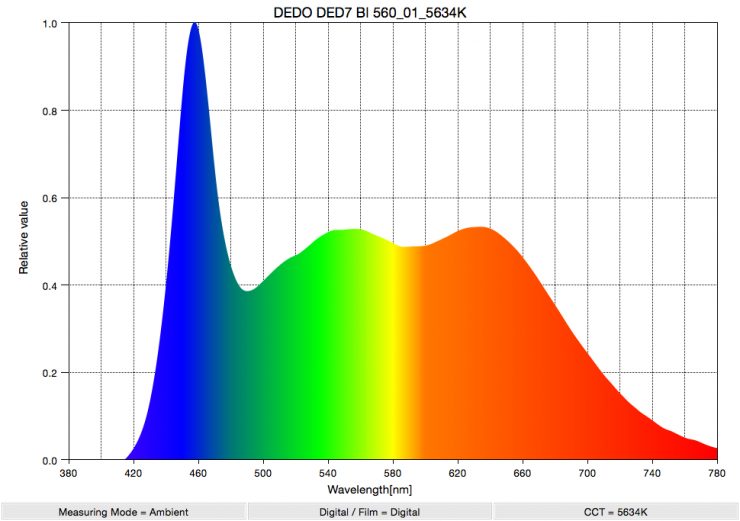
Dedo Turbo Series DLED7 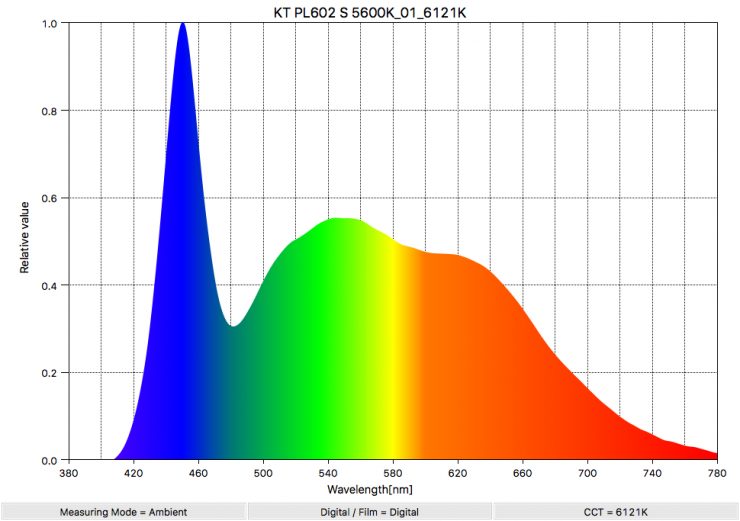
Kinotehnic Pracilite 602
As a comparison, above you can see the spectral distribution for both the Dedo and the Kinotehnik when they are set at 5600K. As you can see the Dedo’s and Kinotehnik’s spectral response isn’t as good at 5600K as that of the CAME-TV.
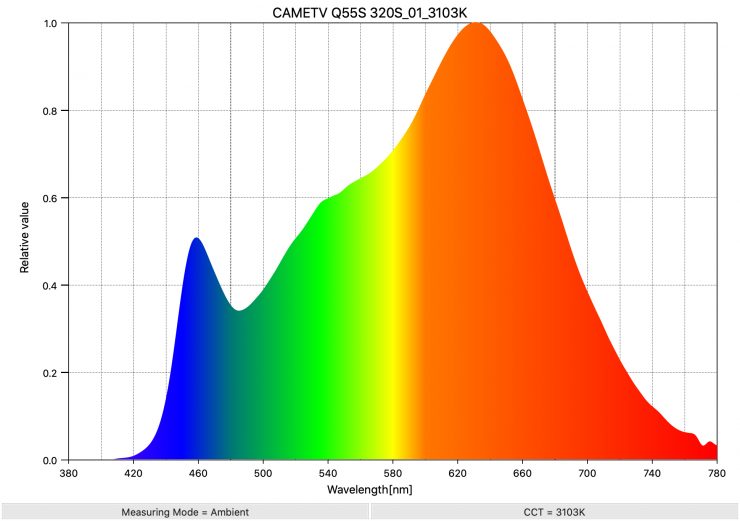
Above you can see the spectral distribution of the CAME-TV when it is set at 3200K. The spectral distribution is very good at 5600K.
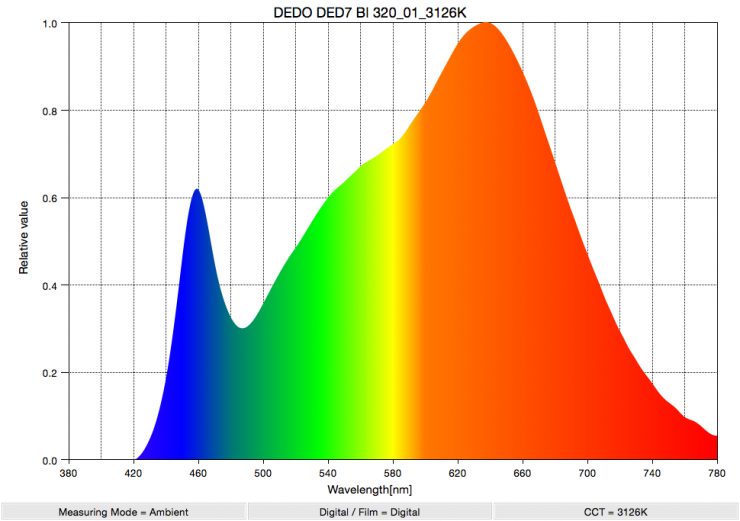
Dedo Turbo Series DLED7 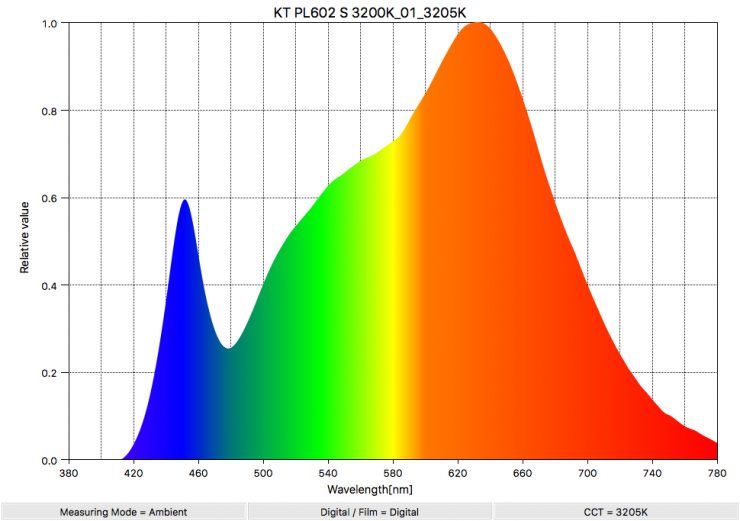
As a comparison, above you can see the spectral distribution of the Dedo and Kinotehnik when they are set at 3200K. As you can see the Dedo and the Kinotehnik have a very similar spectral response to the CAME-TV.
Real-World Performance & Quality of Light
As I always say, photometric scores only tell you part of the story. So how do the scores from the CAME-TV translate into real-world performance?
Small fresnel lights such as this are in most instances going to be used as accent lights for illuminating backgrounds or in scenarios where you need a very tight beam angle where there won’t be any spill.
With fresnels, you really want to be able to direct and control the light, so having a good amount of adjustability when it comes to the beam angle is essential.
Above you can see a quick demonstration of how the CAME-TV compares to the Kinotehnik and Dedo when it comes to beam angle. From this test, it is clear to see that the Dedo offers far more control when it comes to beam angle than the other two lights. The CAME-TV has the most limited range of all of the lights.
I also did a real-world color replication test between all three lights and you can see that above. For this test, all of the lights were set at 5600K and a preset 560K white balance was used on the camera. While you can certainly see the differences between all three lights it is important to remember that different camera sensors react differently with different lights. With the Panasonic S1H I was using, the CAME-TV actually had the most neutral response if you look at how it replicates white. In saying that, I personally found the overall color reproduction of the Kinotehnik looked the best to my eye.
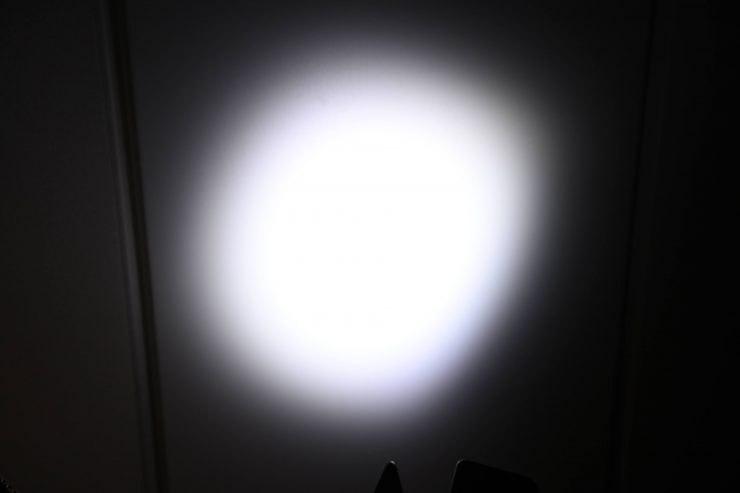
The Boltzen fresnel lights also suffer from quite a harsh fall off and they do have some color fringing on the edges of the beam.
Overall, I was impressed with the performance of the CAME-TV. It can certainly compete with the big boys, but it does have its weaknesses. While it doesn’t have the greatest beam angle range and there is color fringing, the overall color reproduction and output is very good.
Accessories
As far as optional accessories go, CAME-TV sells quite a few items for the lights.
Probably the most useful is the Bowen’s Mount converter which allows you to attach a ton of affordable light modifiers.
Price
The CAME-TV Q-55S Boltzen 55w High Output Fresnel Focusable LED Bi-Color Kit retails for $880 USD. This makes it a very cost-effective fresnel lighting solution for anyone on a budget.
A single CAME-TV Q-55S Boltzen 55w High Output Fresnel Focusable LED Bi-Color light retails for $398 USD.
Competition
There are quite a few small fresnel LED lights on the market, but as I have been comparing the CAME-TV directly to the options from Kinotehnik and Dedo I thought I would show you the differences in price:
| PRICE | |
| CAME-TV Boltzen | $398 USD |
| Kinotehnik Practilite 602 | $967 USD |
| Dedo Turbo Series DLED7 | $1,599.88 USD Light Head $657.95 USD Dedolight DT7-BI AC Ballast TOTAL: $2,257.83 USD |
As you can see the CAME-TV is very affordable when you compare it to the Kinotehnic and Dedo. You could buy five CAME-TV fixtures for less than the price of a single Dedo fixture.
Look, the build quality isn’t as good, it doesn’t have nearly the same beam angle range, and it probably won’t last as long. However, it gives you good color rendition, low power draw, and a nice amount of output.
Other ‘affordable’ Bi-color fresnel LED lights that could be viewed as competition include:
- Genaray Torpedo LED Bi-Color Focusing Flood Light $349 USD
- Lowel PRO Power Bi-Color LED Fresnel $288 USD
- Nanguang CN-60FC Bi-Color LED Fresnel Light $550 USD
- Fiilex P360 Classic LED Light $395 USD
Conclusion
A lot of CAME-TV products are very hit and miss, but the one thing they do quite well is lights. The Boltzen series are very good fixtures for how much money you are paying.
No, they aren’t as durable and well made as the Kinotehnik and Dedo options, but I wouldn’t expect them to be at this price. The CAME-TV has good output, good color reproduction and it offers very good value for money.
My only concern with the light is probably reliability. I just don’t know how well it would stand up to the test of time being used out in the field. Yes, it only costs $398 USD, and if it does break after a few years you could easily buy another one if you needed to. For some shooters, the price point will definitely be one of the light’s biggest selling points. For others, reliability issues over a long period of time may well be cause for concern. The beam angle flexibility is not great, but you can get around that by using barn doors to shape the light.
Is it as good as a Dedolight DLED7 or a Kinotehnik Practilite? Well, yes and no. It certainly can stand toe to toe with those more expensive fixtures and it makes for a compelling option if you are willing to accept the compromises you need to make. I think CAME-TV has done a really good job in making a cost-effective fresnel style LED light that will definitely suit a lot of shooters’ needs.

